| Discover the Reality of Scientific Mythology The Facts of Self-Animating Networks in Nature and a New, Realistic Role for the Mythic Imagination
| 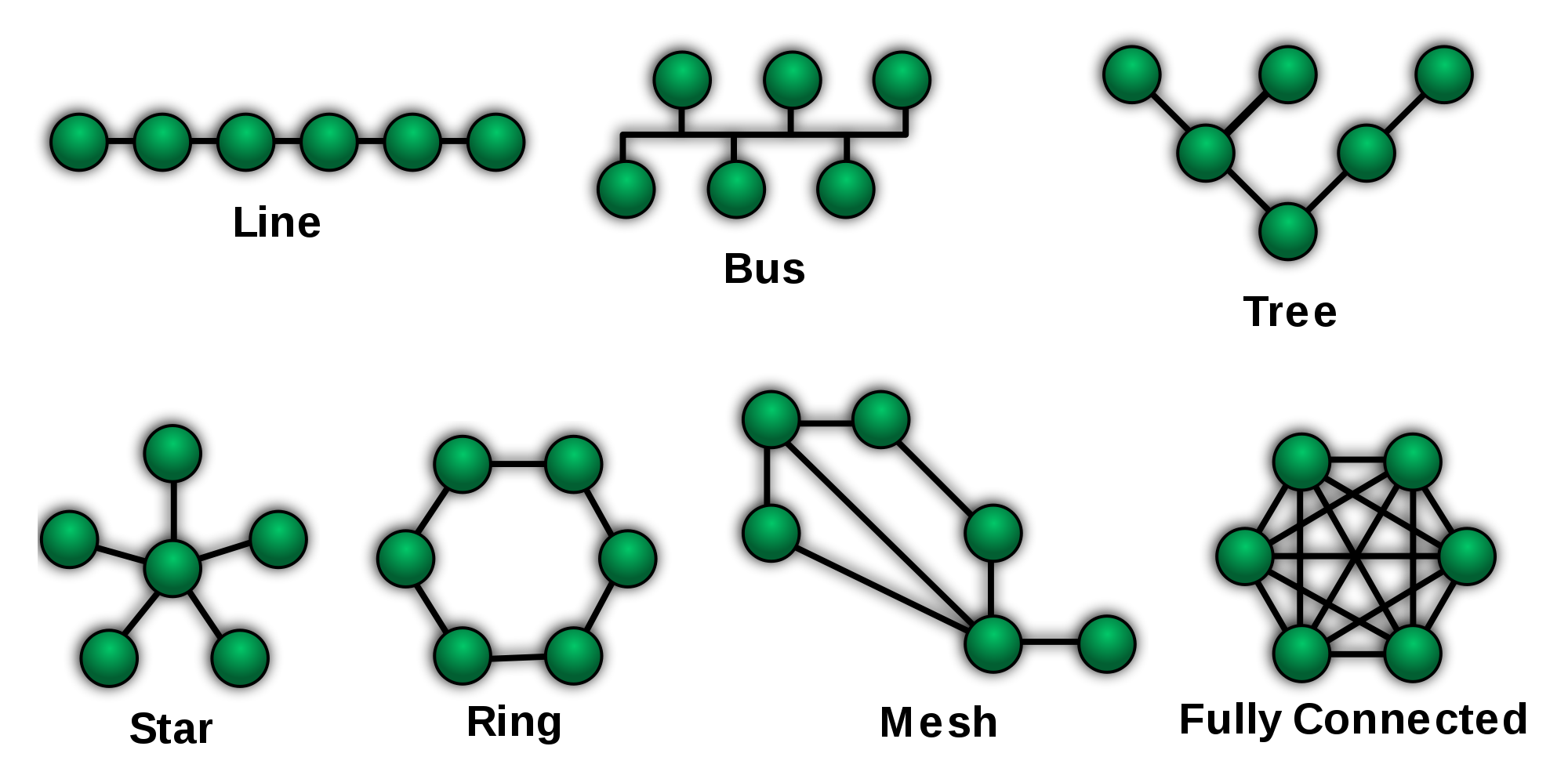
|
|
|
Different Network Structures Create Radically Different Network Dynamics Bottom Line: 1. All things and events manifest as networks: From water molecules to waterfalls and persons to social relationships, the parts and actions that create these are systems which can be represented as network structures. 2. Different types of network structure create different effects: Network structure can create orderly, predictable effects or more complex and unpredictable effects. Most order in Nature is created by network structure which manifests unpredictable, autonomously self-organizing behavior. This network autonomy is pervasive, beyond our control, and effectively animates both our selves and the biosphere. 3. Understanding the effects of network autonomy is essential knowledge of reality: Distinguishing types of network structures and their effects reveals how the world actually works. To think like Nature acts, and act accordingly, requires perceiving the mysterious creativity of network autonomy in and all around us. |
|
 > Summary Overview < Networks are everywhere -- But They are not all the same
The concept of networks is used to describe the ways parts or factors
are connected and influence each other to create things, events, even
ideas. Network modeling assists in understanding how things exist and
function as set of relationships among connected parts that for a
systesm. But different types of network structure associate with very
different effects.
Networks are relationships of partsFour lines in a particular network structure constitute a square: 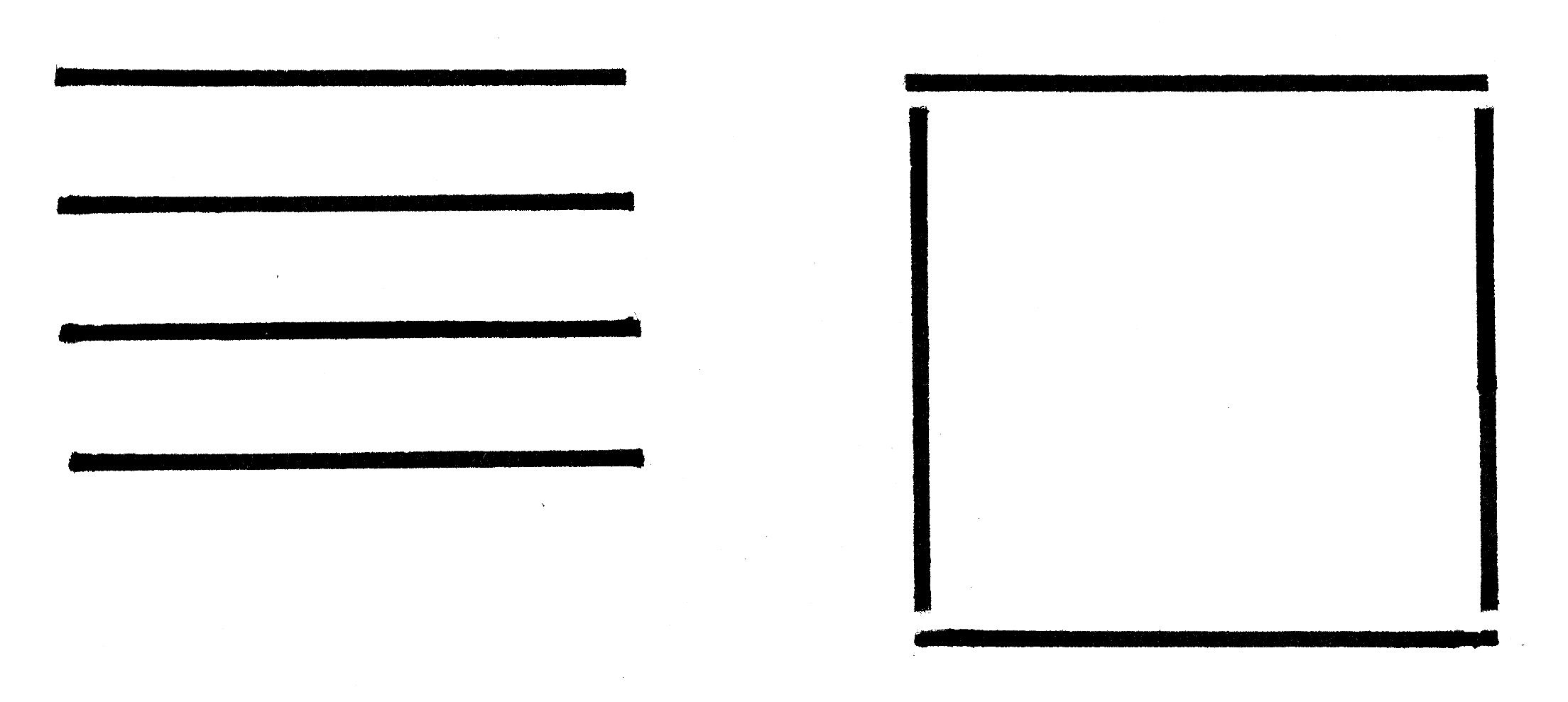 Different types of Networks have different Dynamical Effects
Representing events and systems as networks allows us to identify relationships between parts and how these influence each other. Systems of parts that can change configuration, thus their properties and effects, are manifest dynamic networks. Simple mechanical networks are generally predictable in the changes these can produce. But the connections and influences of complex networks can "do" things that simple, mechanical networks cannot do. Dynamic Networks can change system behavior A basic electrical circuit network: A complex social network: 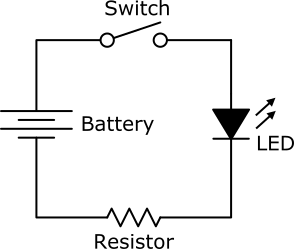 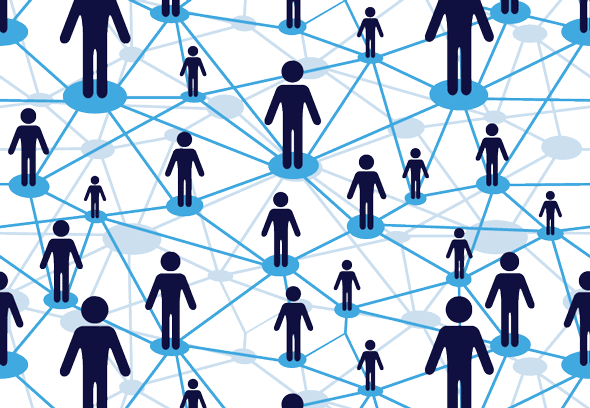 Less complex system networks manifest more consistent, predictable behavior. More complex ones create interdependent actions in each moment and recursive feedback loops that cannot be fully identified and sequence. Networks are bi-dynamical
Progressively
consistent
dynamics :
Inconsistent, interdependent dynamics:
As in 1,2,3 . . .
As in 1,3,5, . . .
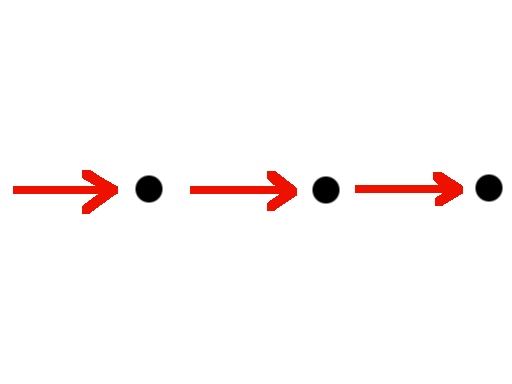 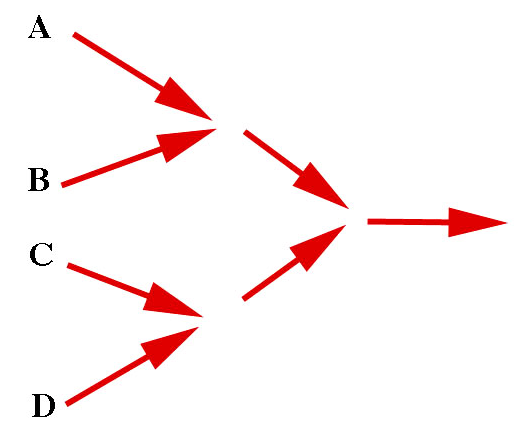 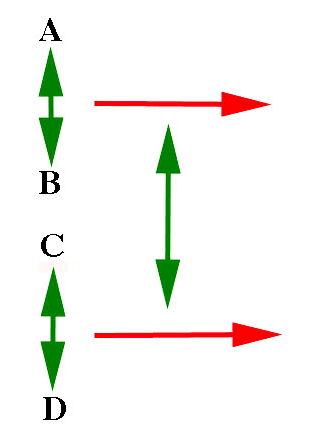 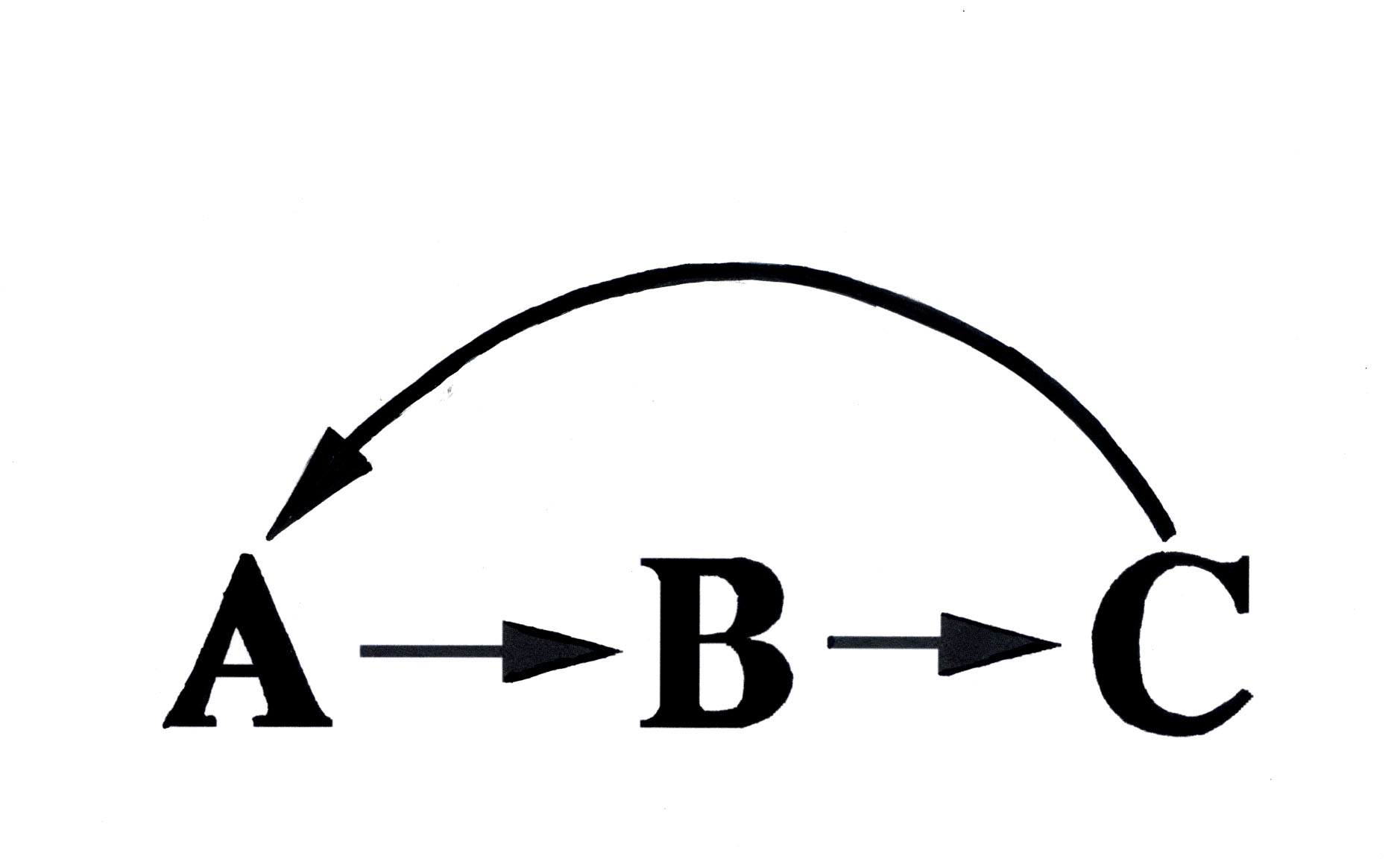 Network Structure Makes a Difference
Simpler net
structure
More complex net structure

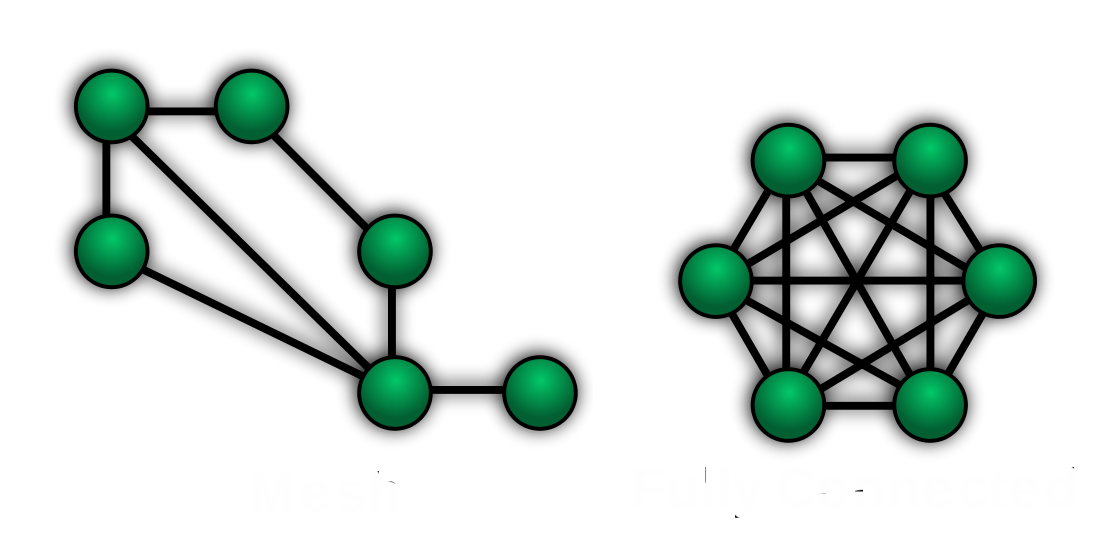 Simpler networks describe predictably mechanical relationships. But greater
diversity and connectivity of parts in a system can lead to levels of
interdependency that generate complexity's synergistic dynamics. This
can produce unpredictable system properties, such as autonomously
self-organizing network operations. Recent science has
revealed that most of the forms and functions in the biosphere are
generated by complex autonomous networks--not the hierarchically
structured ones of predictably mechanistic dynamics. We need to learn
to see our selves and the world as complex networks if we want to
realistically understand how the world works. The
trouble is, these networks are effecitively invisible. We can model
their structure and calculate some of their dynamics, but not all.
How we look is what we seeNetworks autonomously manifest Archetypal Dynamical Character
The emergent origins of complex adaptive networks gives them autonomous intentionality. That enables them to act in ways that both sustain and adapt the operations of their systems. This self-organizing capacity is unpredictable, yet also expresses patterns of behavior that identify types of systems, such as plants, humans, or economies. These differentiating traits are archetypal, indicating characteristic patterns and behaviors that tend to arise from types of system parts networked in certain ways. But each manifestation of a type of network is also individualized by its network autonomy--no two are identical even when very similarly configured. Thus every network is a particularized manifestation of its background archetypal character. To understand each is to investigate how it individualizes its archetypal origins as its unique, unpredictable yet intentional network autonomy. Network science assists in characterizing the archetypal traits of network behavior in terms of dynamical attractors. Network behavior has dynamical character
Predictable fixed point and periodic attractor patterns versus an unpredictable yet self-ordering strange attractor: 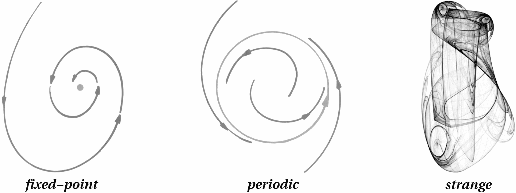 Seeing Networks
Representing things and events as networks requires identifying the parts of a given system and how these effect each other. This analysis provides a way of illustrating how any given thing or event is the manifestation of those relationships, whether the form of a building or the behavior of a person. To "see" networks is to "see" relationships between connected parts and actions. These relationships are not the same as a thing itself. The emergent origins and operations of complex networks are effectively hidden from direct observation. We can only directly access part of the system dynamics that manifest them. Thus abstract modeling is required to create visualize networks as types of relationships among system parts. To "see" networks is to model relationships
Network dynamics are a partly invisible aspect of a system's operations:  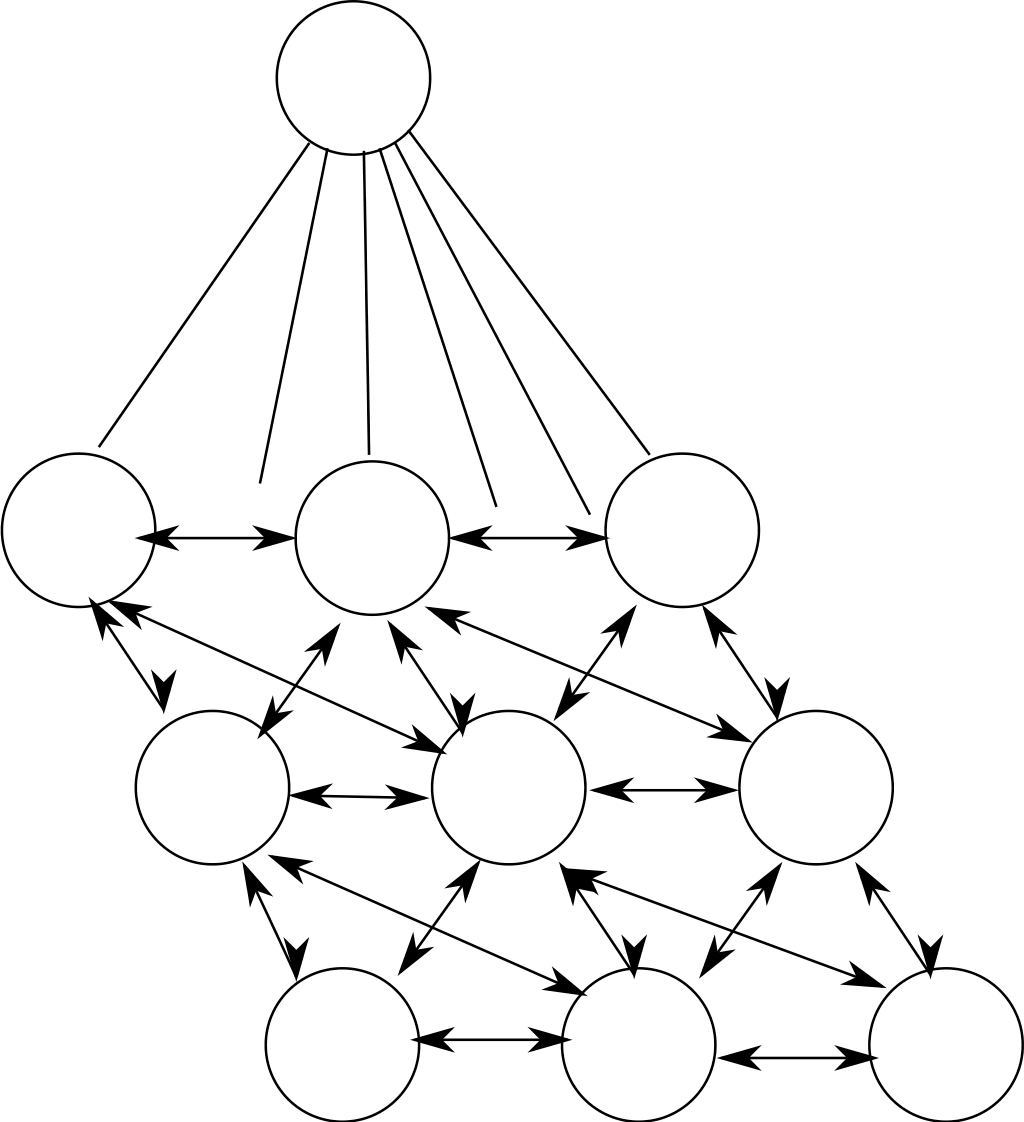 Thus seeing networks involves perceiving something that is typically hidden by the literal appearances of things and events. That requires a sort of "x ray" vision that "abstracts" the relationships from the whole which these create, in order to perceive the manner of its being what it is. The more dynamic and interactive networks become, the more complex are the relationships that generate them, and thus the more difficult they are to perceive. How network science sees the relationships of complex networks
Simpler network structures interact interdependently to generate emergent network autonomy: 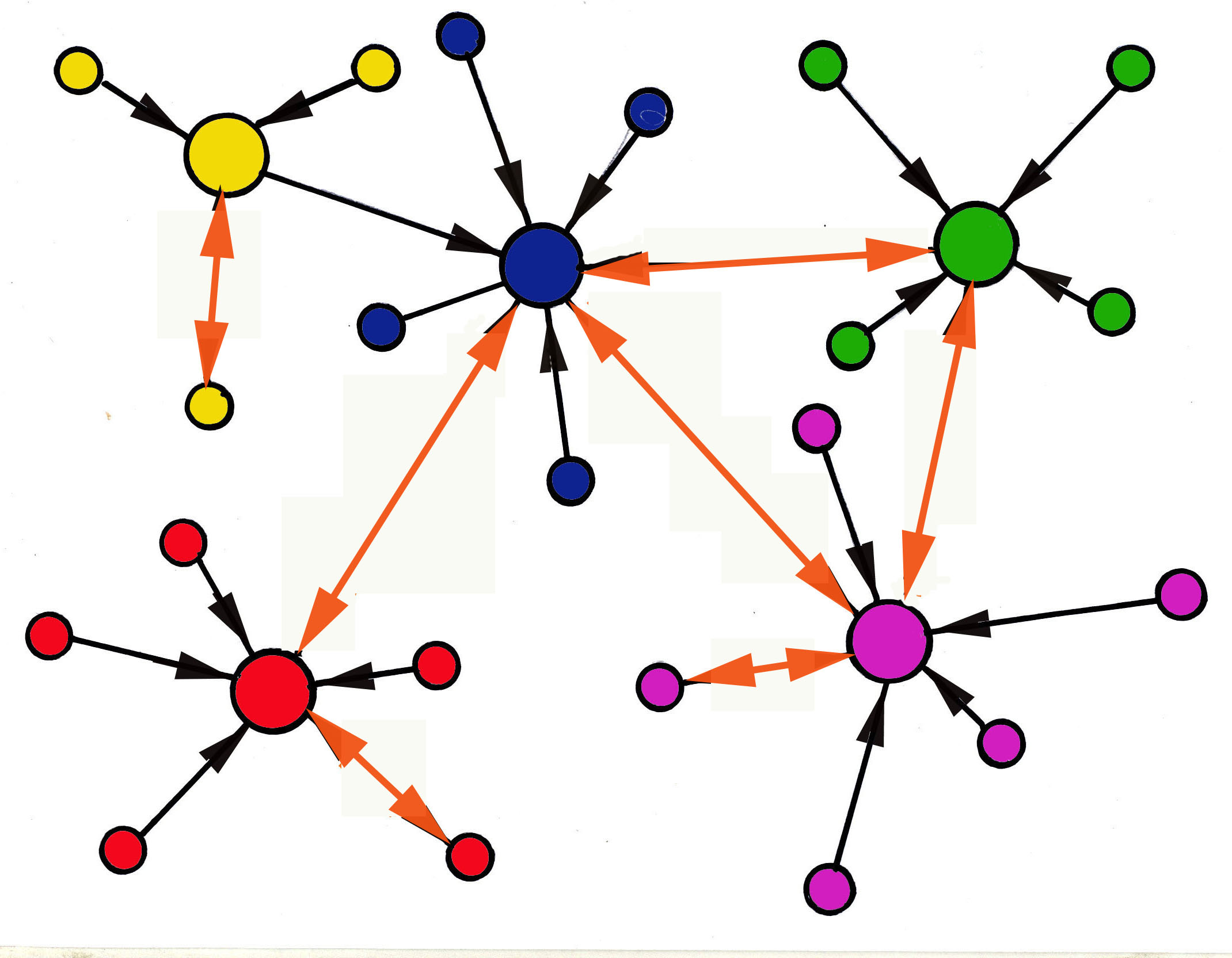 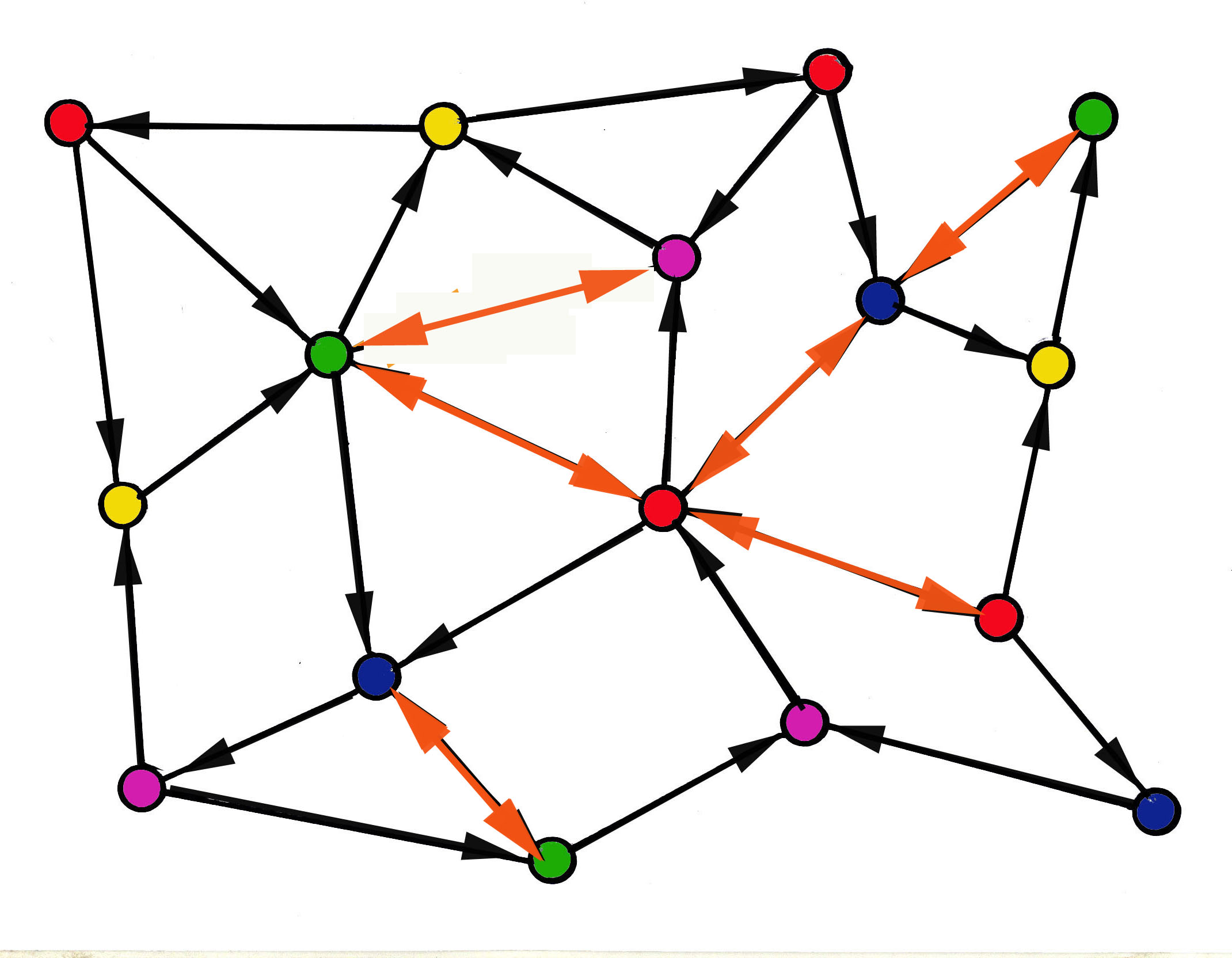 How we perceive networks profoundly shapes our worldview. But our present modern mentality is so obsessed with control we reflexively perceive networks as hierarchies of sequential relationships, since this view suggests we can manipulate and manage them. Thus we are inherently resistant to perceiving concurrently interdependent relationships, with the network autonomy these produce, since that perspective reveals a Nature we cannot control. Worse yet, the new science shows that our attempts to control our environments is crippling the self-sustaining autonomy of natural systems. Seeing networks as hierarchical versus interdependent sets of relationships: 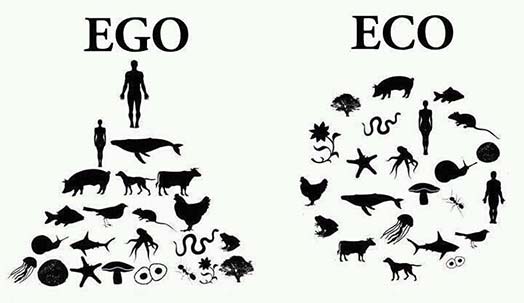 Complex Networks act Autonomously to Animate the World Complex networks emerge from partly disorderly relationships among interdependent system parts through a dynamical condition termed self-organizing criticality. It is this uncertain interactivity that appears to provide them with the capacity to process information and effectively make decisions about how their system will organize its operations--either by repeating past actions or rearranging itself to operate in new ways that could prove more adaptively sustainable. Thus network autonomy effectively create and animates a system. This autonomous, intentionally self-organizing influence acts in response to changing conditions within a system and in its external environments. Many system networks interacting with each other manifest larger scales of autonomous networks, such as societies and ecologies. In so doing, complex networks act reciprocally to generate most of the order and functions in the biosphere around us through their interdependent autonomy--they literally animate the world. The emergent network nature of Nature
Reciprocal interactions among many self-animating networks manifests larger self-organizing networks, such as ecologies: 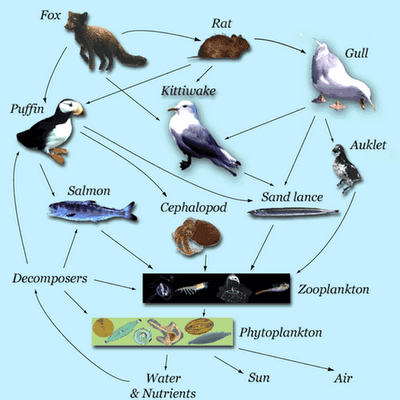 Civilization manifests Control-Obsessed Network Character
Human systems are configured and operate to sustain themselves by technologically manipulating events and environments. In the form of hierarchically stratified, technologically advanced civilizations, the archetypal character of human systems becomes control obsessed. That leads to non-reciprocal, explotative network behavior, which tends to disable the self-organizing operations of the biosphere's larger scale network self-organizing self-animation. Technology, power, and control obsessed hierarchy
Technological power promotes networks of control that exist by exploitation of other networks:   
Understanding how complex networks make us and the world is essential
to thinking like Nature acts, thus to our very survival. But this shift in our thinking requires a radical change in how we understand the origins of order in and around us. We require a new, "netological" philosophy.

Contents Below with Links > Bi-Dynamical Order Creation and Complexity's Autonomous Networks
> The Logic of Network Structure and Dynamics > Network Structure Topology: Types of Connection Make a Logically Profound Difference > The Logic of Complex Network Dynamics: Emergent Self-Organization from Disorder > The Logical Interplay of Dependent and Interdependent Order Creation > The Logical Networking of Networks > The Logic of Ordering Out of No-Where: The Betwixt and Between of Network Self-Organization > The Logic of Networks Beyond Control: The Logical Independence of Network Autonomy > The Logic of Network Autonomy Being the Minding of Matter > The Logic of Archetypal Dynamics in Network Operations > The Logic of Networked Reality: Complex Network Autonomy Animates Self and World > The Logic of Network Character: The Archetypal Traits of En-Spiriting Information in Network Self-Animation > A Netological Philosophy: Thinking Like Nature Acts through Two Types of Network Dynamics > The Logical Mystery of Emergent Network Order Creation > The Logic of Networks as "Dynamical Attractor Landscapes" > The Illogical Relations of Humans to Complex Networks: Our Obsession with Control Equals Ignorance of Network Autonomy  Network Dynamics and Their Radical Implications Bi-Dynamical Order Creation and Complexity's Autonomous Networks
Perceiving the different ways network relationships create order is essential to understanding the autonomous self-organization of natural systems. For that we need the insights of complexity and network science. The implications of those insights, explored below, can be summarized as follows: 1. Bi-Dynamical Order Creation: Order is created through two types of dynamical phenomena. The first is composed of sequentially dependent events that are fully identifiable and predictably deterministic--as described in the Laws of Physics. The second presumably arises from the first, but is composed of simultaneously interdependent events that are not fully identifiable and are unpredictably deterministic--as described in the science of chaos and complexity. The first type is proportionally consistent, thus fully explainable and can be characterized as mechanistic. The second type is disproportionally creative, thus not fully explainable, and so is termed emergent to distinguish if from the predictable dependency of mechanistic order creation. Both modes are involved in the creation of the majority of forms in our biosphere. Thus it arises from and is sustained by a bi-dynamical domain of order creation: the mechanistic and the emergent dynamics of order creation. If we are to think like Nature acts, we must think bi-dynamically. 2. Mechanistic versus Emergent System Networks: Things formed by multiple parts constitute systems. The arrangement of connections between and activity among those parts constitute a system's network. Networks can be relatively static or dynamic. A dinner plate has a more static network of relationships between its physical parts. A city system has more dynamic network relationships. Network dynamics can create a system's form and operations through predictably mechanical events, as in a clock, or through unpredictably emergent dynamics, as in a city. Unlike mechanical system networks, the emergent creativity of the networks of complex systems cannot be fully described or explained. To think like Nature acts we must think in terms of both types of systems and networks. 4. Network Autonomy: Emergent networks can produce autonomously self-organizing behavior that both maintains and adapts the operations of their systems. Emergent networks can process information and effectively "think for themselves." Network autonomy is what makes us alive by intelligently animating our body/mind systems. But it is also active in non-biological systems like ecologies and economies. To think the dynamical reality of most human and non-humans systems we must perceive the pervasive operations of network autonomy. 5. Collective Network Autonomy: Multiple autonomous networks interact interdependently to generate collectively emergent meta-networks, from bodies to economies, ant colonies and the biosphere itself. Most order in and around us is an emergent property of reciprocally interdependent autonomous networks. To perceive the interdependent dynamics of meta-systems such as ecologies and societies, we must think in terms of radical reciprocity. 6. Archetypal Network Autonomy: Autonomously self-organizing networks manifest unpredictably variable yet identifiably characteristic patterns of behavior. Such networks are partly unique expressions of a characterizing set of qualities that identify them as types of networks. Rodents constitute an range of animal traits that identify them as a type of complex system whose emergent networks express characteristic traits of form and behavior. These traits are termed archetypal because they are a potential field of possibilities for being a rodent but do not dictate the exact form and network behavior of any given rodent system. Mice are a identified by subset of archetypal traits associated with the characteristic of mouse network autonomy. A particular mouse is an instance of the network type of its species. But each individual mouse expresses its archetypal potential with some uniqueness of network autonomy.At each level, systems and networks manifest autonomy as archetypally distinct behavioral personality: rodents, mice, a mouse. To think about how network autonomy creates the world we must think archetypally. 7. Limitations of Autonomous Network Definition: Emergent order creation is not fully identifiable through reductive scientific analysis, thus not completely explainable. Emergent order creation and network autonomy are effectively invisible. Our ability to precisely define and understand these aspects of reality is severely limited, despite the fact that they create the majority of order in the biosphere. To think like Nature acts we must think in more than scientifically reductive ways. 8. Network Autonomy Makes Nature Uncontrollable: Due to its emergent basis, network autonomy cannot be directly manipulated and controlled. Attempts to impose external control on autonomous networks can debilitate the sustainable and adaptive traits of their systems resulting in system collapse. To live sustainably within the reciprocal network autonomies of the biosphere we must facilitate rather than disrupt these relationships. 9. Network Autonomy and the Necessity of Intuitive Understanding: Adequately realistic awareness of how the world works requires some method of perceiving and conceiving how emergent creativity and network autonomy "make the world." Because these are deterministic, even intentional, yet not predictable, knowledge of "how they tend to behave" and thus how to interact adaptively with them cannot be precise. But we can intuitively assessing their behavioral tendencies as sets of archetypal characteristics that constitute the personalities of autonomy in different networks. Available scientific evidence provides a basis from which to extend understanding complex systems and their emergent networks by this intuitively exploring the behavioral character of these effectively invisible but crucial aspects of reality. 10. Civilization's Aversion to Network Autonomy: Human obsession with controlling phenomena leads to creation of hierarchical, technologically enhanced, control oriented human systems--such as governments, armies, social institutions, industries, or corporations. These reinforce assumptions that all phenomena can and should be controlled. The resulting human mentality is profoundly resistant to acknowledging and acting reciprocally with the autonomy of the natural networks that create and sustain the biosphere. Our debilitating impacts on the autonomous operations of those networks is causing their collapse. Our own survival requires us to develop intuitive methods of understanding the crucial roles of emergence and network autonomy. To think like Nature acts, and act accordingly, demands a cultural practice of continually countering our control oriented focus on mechanistic order creation. The science of complexity and network autonomy now provide an empirical basis for this cultural transformation. The Logic of Network Structure and Dynamics
Networks as Static and Dynamic Relationships among System Parts The relationships between a system's components are what form their networks. Whether the system is boat or a human social group, it is the qualities of the relationships between those parts, how they act upon each other, that generates the system's recognizable order and patterns of behavior These relationships can be relatively static, meaning little change over time, or actively dynamic, meaning there is ongoing change in how parts are connected and effect each other. The pattern of more static relationships, like the structure of a molecule or house, is mostly consistent, thus easy to describe and explain. But the pattern of complex dynamical relationships, such as the interactivity among millions of neurons in a human brain, is constantly variable and virtually impossible to completely describe. Houses built from the same materials have vastly different forms and functions because the network of relationships between their parts varies. But the network relationships of any given house remain mostly static. The systems of human brains have are based upon similar materials and a shared general physical structure. But the network of relationships between their parts is both vastly more complex and dynamic than that of a boat or house. But in both cases, the network of relationships constituting a system's network is not a thing in itself. Thus the network, as a set of relationships between parts, is not overtly obvious or visible. We can perceive the whole of the system but often not the traits of all the relationships between its parts The more complex the dynamics of a system, the more interdependency of effects its parts have on each other, the more inaccessible to direct examination become the relationships that constitute its network operations. Gaining understanding of the properties of networks, and the radical differences between those with relatively static or consistent relationships and those with more dynamically complex sets of relationships, is aided by abstractly visualizing the traits of how system structure generates them. Network Structure Topology: Types of Connection Make a Logically Profound Difference The most basic insight of network science it its abstract modeling of how system parts are connected to create the relationships of their networks. These models give us a way of visualizing networks as an abstract topology. These diagrams represent the logic of placement of system parts in terms of their networked relationships. Network models do no look like the systems they represent. Instead, system parts are represented as nodes, and the relationships between parts as links between those nodes, standing for some form of connection between parts. These links indicate pathways across which system parts influence each other, creating what is termed feedback. Feedback can take the form of energy, such as heat or mechanical force, or the exchange of more abstract information, by way of which parts influence each other, and thus generate the overall operations of a network. Feedback is particularly crucial to the interdependent dynamics of complex systems. It is characterized as input and output. System parts are effected by the outputs of other parts that influence them as inputs, then respond with outputs of their own. So feedback is a flow of inputs and outputs that passes between system parts and between distinct systems. The patterning of connections between nodes influences how inputs and outputs among system parts aggregate to the overall dynamics and operation of a system. Networks can have more linearly sequenced patterns of linkage between nodes, as in a simple series of nodes each connected to the next in a line. But connecting links between nodes can also be or more multiple, creating redundant patterns of linkage. The latter are represented by the "mesh" and "fully connected" examples in the illustration below. Types of network topologies promote different network properties
Abstract models of different patterns of node linking or connectivity:  Linearly sequenced connections, in which one node is connected to only one or two others, limit the flow of feedback between nodes. Actions and reactions of system part, as inputs and outputs, tend to be more sequentially dependent when linked in this manner. This type of network connectivity is typical of mechanical systems like clocks and motors. More multiply connected patterns, as in mesh and fully connected models, can amplify the amount and simultaneity of feedback between nodes. Thus the latter tend to generate more interdependency of actions and reactions, leading to more of the nonlinear dynamics of complex systems, with their emergent properties and self-organizing networks. In the illustration below are models of a centrally structured pattern of connections, having a single hub with multiple links, then a de-centered pattern, having multiple hubs, and lastly a distributed pattern, in which most nodes are multiply connected to other nodes. Nodes with multiple links are termed hubs. These often act as organizing factors in the flow of feedback across a system. Three basic types of network topology
The arrows on the link
lines indicate directions of flow of feedback between nodes. Links can
represent transmission of input and output influence as traveling in
either a single
direction or both in directions between nodes. The orange
arrows pointing in both directions identify links that transmit
feedback in both directions, which can occur simultaneously,
making the resulting effects difficult or impossible to
distinguish. But even single direction flows of feedback can circulate
around loops of node connection, feeding back into itself in ways that
can add additional aspects of input and output.Centralized single hub: De-Centralized multi-hub: Distributed fully connected: 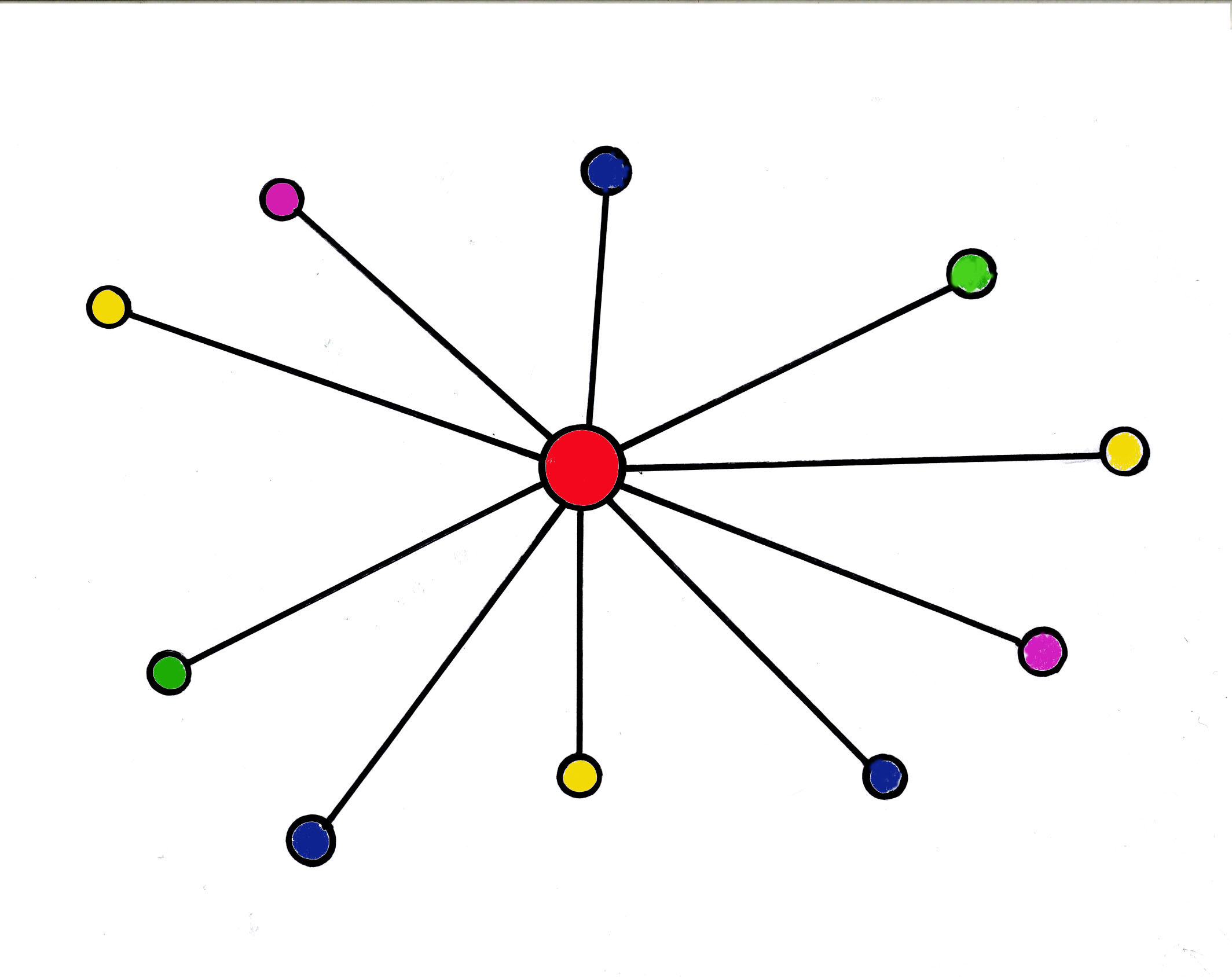   Another mode of representing multiply connected networks positions the nodes on a circle and draws links across the circle, giving a further way of imaging these redundant connections and their simultaneous flows of feedback Peripherally modeled network topology
This modeling can be further amplified by representing the network more
three-dimensionally, giving us a slightly more real world impression of
network structure..Network nodes are placed on a circle with links between and color coding indicating more closely connected nodes: 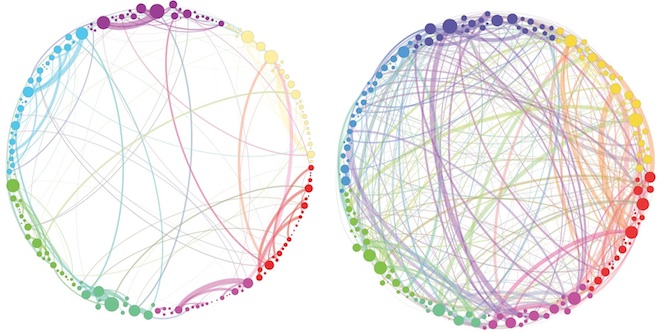 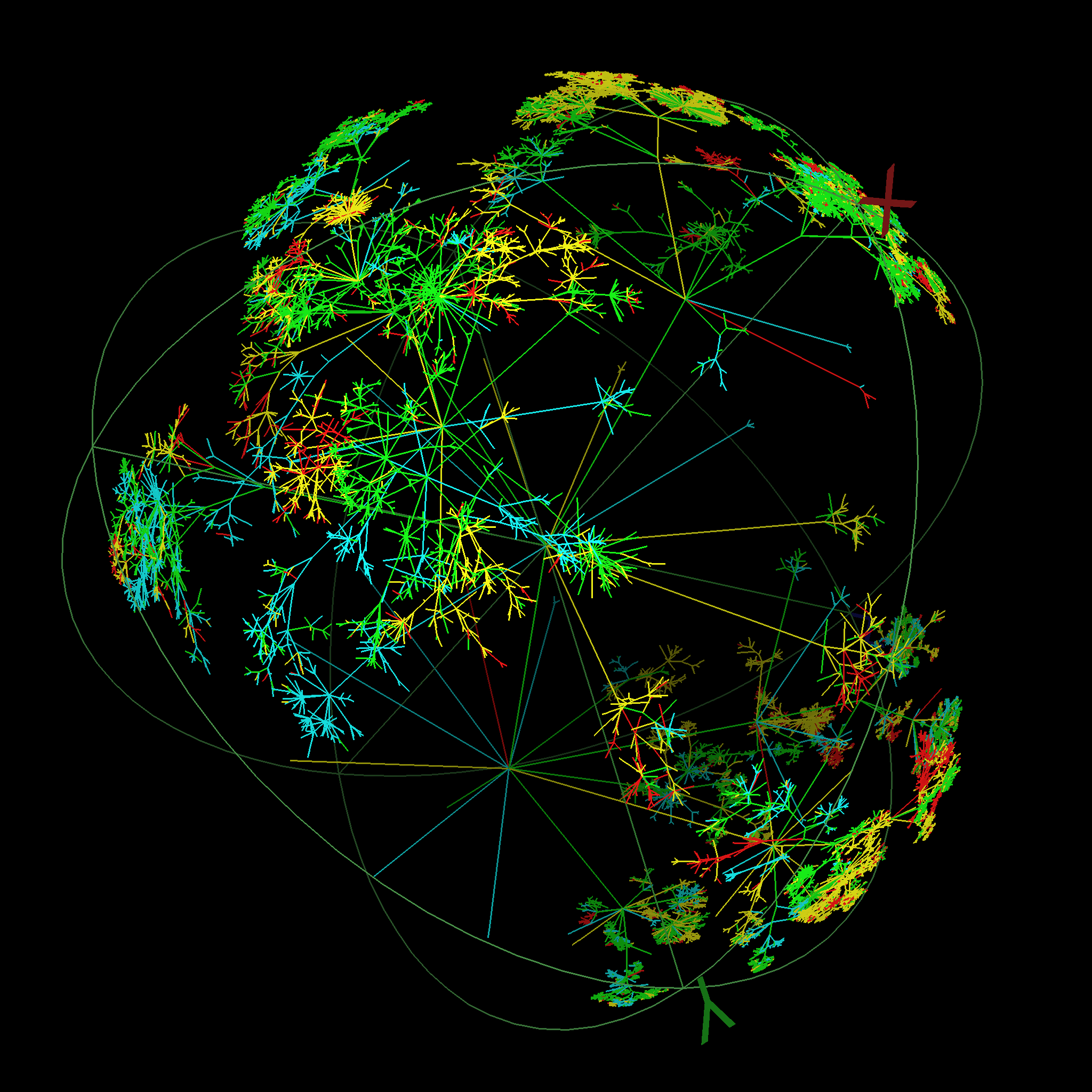 Even in these simplistic diagrams it becomes possible to conceive how feedback between nodes can become mutually modifying, leading to changes in feedback influence across a network. Outputs from two or more nodes can effect each other simultaneously, creating further factors that act as outputs and inputs: feedback can change itself as it flows around the network, creating patterns of simultaneous interdependency that cannot be effectively sequenced. It is this type of system structure that particularly associates with emergent properties and network self-organizing autonomy. Predictable causes and effects can be understood as linear sequences of action and reaction in which each is dependent upon the preceding one. These can aggregate into convergent flows of causes and effects, resulting in a single specifiable condition. Predictably deterministic dynamics
But network
interdependency results in an ongoing flow of concurrently
interdependent influences having synergistic effects that do not
manifest this hierarchic
progression: there is no straight line to the causal effects. Thus we
must attempt to think of them as having instantaneous interactions
involving feedback that pass through multiple network nodes then
loops back to prior ones, circling round and round in an
ultimately un-differentiable confusion.Succeeding events, each dependent upon the previous-- differentiable dynamical progression:    Unpredictably deterministic dynamics
Simultaneously interdependent events--Undifferentiable dynamical interaction:    The basic elements of network modeling provide a way of conceptualizing the differences between forms and events that are predictable and explainable, and those that are not. When we "see" a house as an architectural drawing, we conceive it as a non-complex network of predictably dependent structural relationships, of nodes and links, that can be fully quantified and calculated. We can explain how such a physical network functions. But when we "see" house as an expression of a cultural network, it becomes an effect of a complex adaptive system with a very different type of network structure--one with dynamic relationships that are not predictably dependent, thus which we cannot fully map or explain. But that awareness assists in realizing why the meaning of a house as a physical structure versus as a cultural phenomena is profoundly different. While these models are useful in conceiving differences in structure, they are only reductive abstractions, not literal pictures of actual, real world systems and their networks. They cannot provide us with any adequate sense of the simultaneously interdependent activity in complex networks or their continually variable operations. Representing such network operations in real time, as they happen, is astonishingly difficult, if it is possible. Complex networks are by definition rarely static. Connections between nodes can be modified or created moment to moment, changing the operational properties of the network and thus configuration of the system as it responds to changes in its environment. An extreme version of this dynamical flexibility is the metamorphic event of a caterpillar's self-induced network transformation into a butterfly. In this instance a network completely re-self-organizes its system and its self into radically different forms and functions. But most natural systems are doing this to some degree on an ongoing basis. Video graphics assist somewhat in modeling these types of network activity and transformation. But even with moving images the challenge of representing simultaneity is profound. Though network modeling is useful in getting some logical impression of how complex networks operate, it is often not possible to fully model their structures and activities. It is in this regard that complex networks can be said to be effectively invisible to our objective, mechanically based perceptions. Further consideration of the logic of how these networks "do what they do" assists in appreciating this limitation on our capacity to fully analyze them. The Logic of Complex Network Dynamics: Emergent Self-Organization from Disorder The traits of networks associated with complexity and system-autonomy are in effect anti-structural in that there is no progressive transition from one single instance of structure to the next. The structure and activity in one moment can emerge from that of the preceding moment in ways that are disproportional and unpredictable, yet are not randomly accidental. The given structure of any moment does not fully determine that of the next. So successive structural states of network and system are not entirely dependent upon preceding ones. These facts underscore the evident relationship between such uncertainty and the emergence of a network's capacity to change its operations and modify it systems--though this provides no exact causal explanation for such phenomena. It is here that the fundamental question about emergent causality arises. What can possibly be creating order out of this discontinuous thus disorderly activity? According to our standard cultural definition of causation, changes occur as direct results of preceding events, as actions that have proportionally consistent thus predictable effects. You throw a ball with X amount of force and it travels a predictable distance. But the dynamics of complexity, and particularly complex adaptive systems, do not manifest this progressive causal sequencing. Thus one can consider that possibility that an additional causal condition is generated by complexity's dynamical interdependency of factors, suggesting a bi-dynamical domain of causal conditions. One is the familiar domain of the Laws of Physics, that predictably constrain what can and cannot happen to matter and energy. The other is the unpredictable but not random order creation of complexity. Presumably, the latter derives from the former in that certain relationships among physical entities enables complex dynamics and thereby emergent causation of otherwise not possible forms organization and autonomy. But how does this work? What governs this unpredictable causal phenomena? Physical science has provided much information the dynamical conditions involved in this conundrum but not conclusive description or explanation. But complexity science does provide further insights. The property of inconsistent and disproportional emergence associates with what is termed self-organizing criticality in complex network activities. Criticality refers to a condition in which a system's structure is on the verge of significant change in its ordering and operations. A subsequent shift can either result from a network re-organizing or collapsing into more chaotic dynamics that cannot sustain the general form and operations of the system. Criticality relates to a notion called the edge of chaos, represented as a boundary zone between the self-sustaining dynamics of complexity and the more erratic, though still organization generating ones of chaotic dynamics. Thus a spectrum is conceived that shows consistently ordered or stable activity on one end that gives way to the partly disorderly dynamics of complexity's more radical interdependency, then the boundary of criticality or edge of chaos where dynamics become fully chaotic, beyond which is randomness. Chaotic here means activity that is not random, as it can emergently generate more ordered patterns out of disorder, but cannot sustain that order as do complex dynamics. Overall complexity increases toward the edge of chaos. The dynamical range of order creation
From orderly ordering to complexity's disorderly self-ordering, then chaos' disorderly but not self-organizing order creation, and lastly non-ordered randomness: 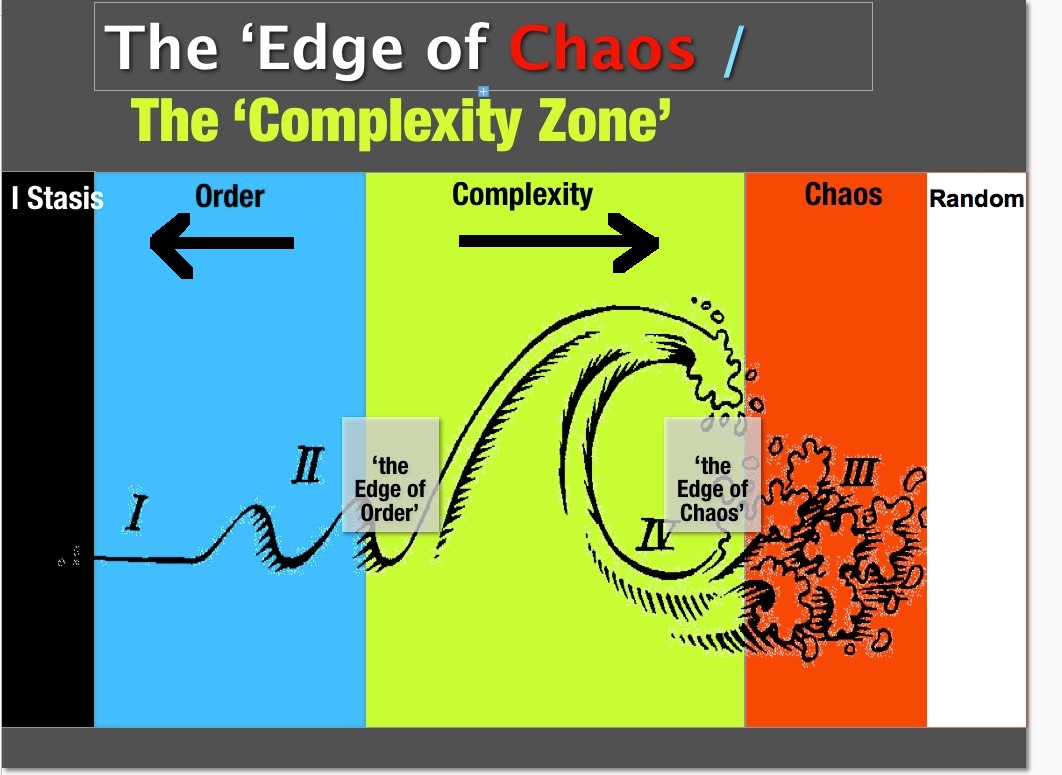 The zone of complexity is sometimes called the creative domain, as this is where complex order is created. There is a maintenance aspect to this creativity as well as an adaptive one. Moment to moment, complex networks continually re-create the ordering operations of their system's characteristic forms and functions through self-organizing criticality: even relative continuity of a system, what is referred to as homeostasis in body self-regulation, is a continually emergent phenomenon. Adaptive changes in system configuration and network operation also emerge from this same dynamical condition of self-regulating criticality, happening near the boundary of chaotic dynamics. Both are manifestations of network autonomy and volitional action initiation. The dynamical range of new order creation The disorderly yet self-organizing dynamics of complexity near the "edge of chaos" is the source of new and adaptive order creation: 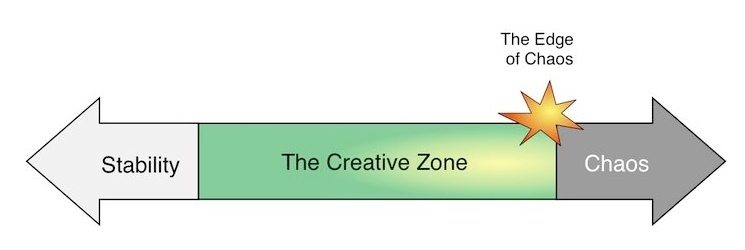 This lesson is familiar in the evolution of human science and technology: significant innovation is discouraged by strict adherence to established concepts, standards and designs.Only with the partly disorderly diversity of complexity do we get emergent properties in general and autonomously self-organizing system networks in particular. A significantly new scientific theory or concept of technological systems is often not logically consistent with preceding concepts. It is an emergent conceptual network of evidence and related concepts. But there is a logic to this emergence in that only an inconsistent, disproportional break with preceding ones can generate genuine novelty--a creative leap that can necessarily derives from disruption of preceding conditions that creates new interdependencies. Similarly, there is also a logic to the fact that the specific actions and reactions taking place in the disorderly simultaneity of interdependency in complex networks operating near the edge of chaos cannot be fully accessed and described. If many events are both occurring and modifying each other simultaneously, then there is no sequence to their causal actions and reactions. There is no progression to quantify and interpret. This obscurity is represented by the white box versus black box model of what can be known in mechanistic terms. A white box indicates a context of dynamic activity that can be fully accessed and analyzed. A black box suggests dynamics that remain obscure to all attempts to directly observe them. Thus we can only observe the before and after effects of complex system interdependcy and network self-organization. The initial inputs to and overall outputs of network operations often can be quantified and calcuclated, but not the transforming events that create new organization and network properties. The "Black Box" obscurity of network operations in complex systems
The feedback dynamics and information processing in emergent networks are not accessible to direct observation and identification 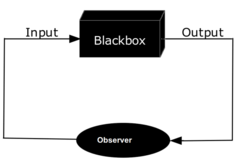 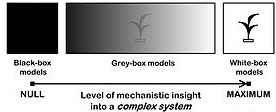 The Logic of Network Adaptivity: Four Interacting Factors of Complexity in Autonomous Networks Further insight into the traits of emergent networks is provided by identification of four crucial factors. These are identified as diversity of system parts, types of connectivity between those parts, interdependency of the relationships between parts, and degree of adaptive capacity that these enable. So there is diversity, connectivity, interdependency, and adaptivity. The adaptive factor is also described as a learning capacity. A network cannot adapt its system unless it has the capacity to retain information about the history of the system and its external environment. These factors can be imagined as four adjustable dials, with which the relative degree of each can be increased or decreased. The relationship between these factors has profound effects and is part of what networks do when organizing or re-organizing their systems. In general, the optimal range for these factors is moderate. Extremes of any factor can decrease dynamical complexity and disable system/network operations. The four interacting factors of complex system network adaptivity
The level of any or all
factors can also be influenced by changes in a system's external
environment, to which the system's network responds. An example is a social system of humans whose external
environment changes to reduce available resources such as food. The
network of the social group might then adapt by dispersing into smaller
groups that migrate to a different local environment in search of food,
reducing overall connectivity, diversity and interdependency.
Similarly, economic systems produce emergent network re-organization
that can increase or decrease these factors. The crucial point is that robust complex system networks arise from moderate levels of these factors
yet also can act to regulate the relative proportions between them
within their own systems: network autonomy can manipulate the basis of
its own emergence.Moderate ratios of diversity, connectivity, and system parts relates to their degree of adaptive complexity: 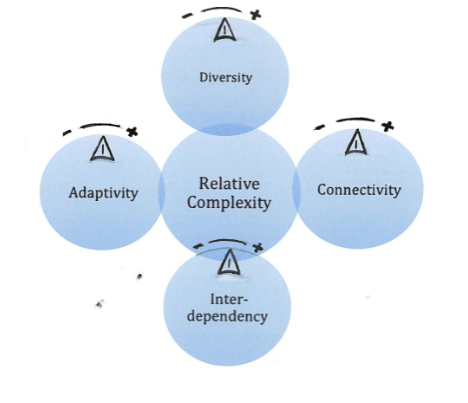 The Logical Interplay of Dependent and Interdependent Order Creation The emergence of unpredictably deterministic order creation from conditions of interactivity among predictably deterministic dynamics seems mysterious or magical because it is not specifiable as a sequential mechanistic process, thus not completely explainable. We can identify the above discussed logic that simultaneously interdependent, mutually modifying feed back flows between system parts that are explainably deterministic seems appropriate to creating exceptional dynamics that could be synergistically transformative. Nonetheless, those dynamics, because of non-sequenceable simultaneity, remain beyond complete identification and evaluation. However, given the evidence for their existence, we can proceed to explore the interplay of predictably dependent and unpredictably interdependent dynamics of order creation--the bi-dynamical reality of Nature. The predictable dynamics of material physics as the basis for the interactive interdependency of self-organizing criticality and its emergent ordering that in turn amplifies emergence: 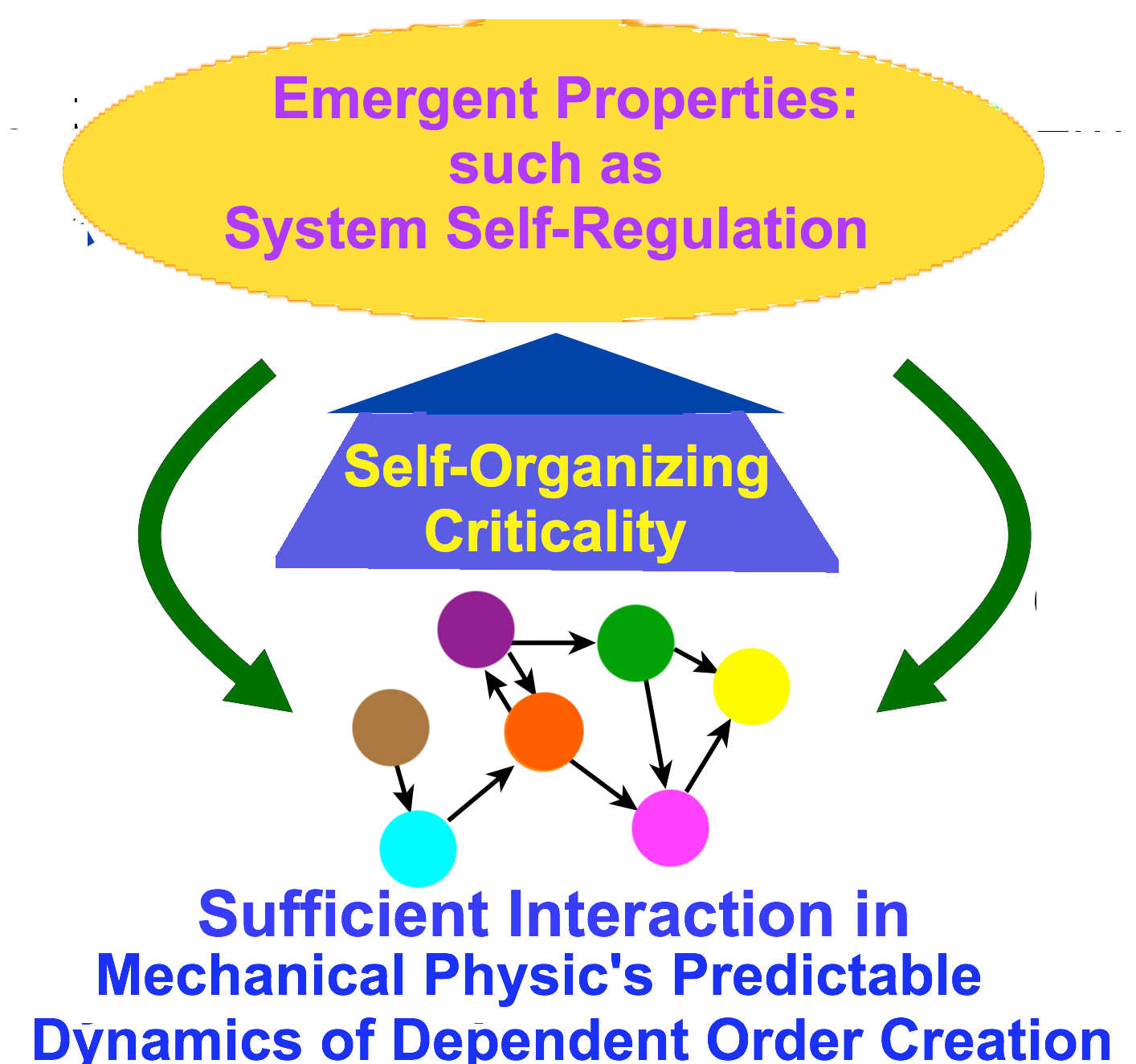   The Logical Networking of Networks Modeling networks as discreet sets of nodes and links can make them seem like distinct, even fixed entities. But the complex systems and networks that compose Nature are in fact so dynamically active, variable, and interdependent that their boundaries and relationships are elusive. Examine any complex system in detail and you are likely to find it is actually a system of systems and a network of networks. The Logic of Patchwork Interdependency and Aggregate Meta-Networks with Overlapping Autonomy Examine it in its external environment and you will discover it is intimately networked into ever larger systems of systems and networks of networks. This interlinked cross--boundary meta-network structure of relationships is intrinsic to how the self-organizing autonomy of networks emerges at larger and larger scales. A baseline level of a human body/mind system includes not only billions of cell systems but also a vast variety of micro-organisms that live in and on the body which are integral to its overall functioning. Human digestion is not possible without billions of diversified bacteria living in the gut. Depending upon what food a person ingests these organisms will, in performing their own internal metabolic operations, generate byproducts that have different chemical properties. These in turn effect the operations of the body's organs. The bacteria constitute discrete systems and networks, yet they are intimately interdependent with that of the human body. Each manifests discrete aspects of network autonomy. These overlap and yet are some times in conflict, as with bacterial networks that are part of our body's systems but can also disrupt body functions. Individual birds in a flock or fish in a shoal have considerable autonomy. Each seeks to avoid predators. But by synchronizing their movements they patchwork together to form a single meta-network that frustrates a predators efforts to single one out for attack. Simple rules that create complex network behavior Fish following cues from a few neighbors generate emergent meta-network autonomy: 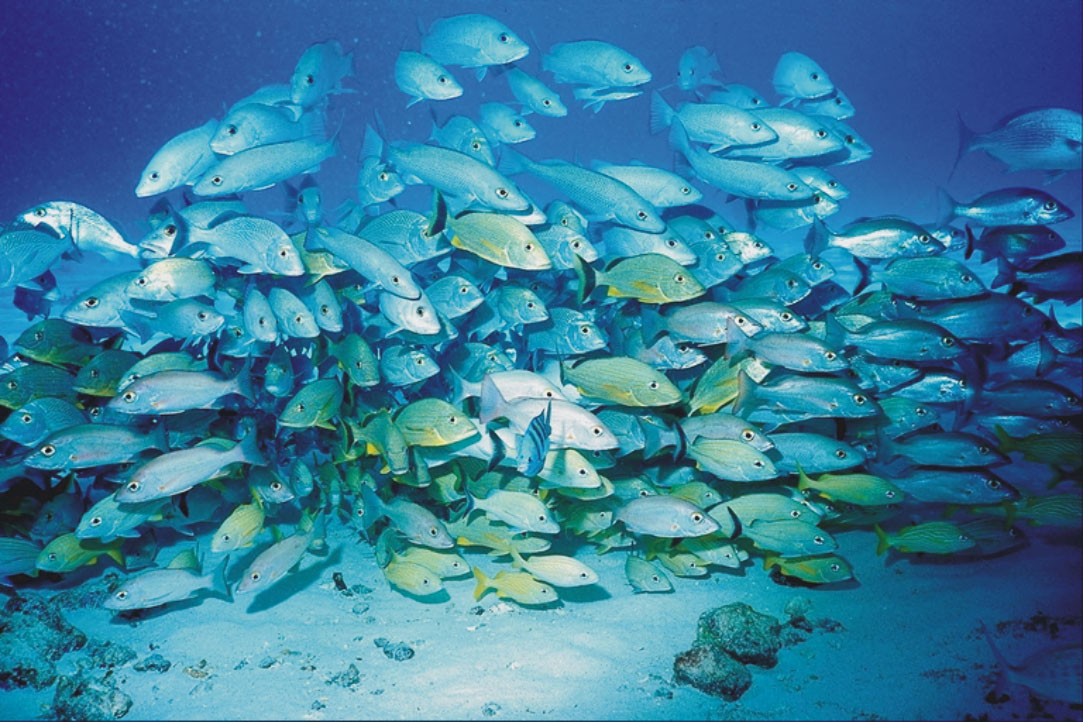 Termed "murmmeration," this effect derives in a bottom-up manner through the correlation of separate networks, the individual autonomies of the fish, in which each copies the movements of its nearest neighbors. Yet when a shoal is being pursued by predators. individuals will sometimes break with this collective effort and select to act independently from the group. All this occurs as each autonomous network processes information about others in its environment then acts in ways it selects as beneficial to itself. The collective effect is a dynamical example of networks operating in criticality near the edge of chaos. The meta-network of the shoal is constantly in flux, re-organizing itself continually on the verge of fragmenting and reforming. Such is the teetering instability at the basis of complex network self-organizing criticality. Meta-system network autonomy manifests in the collective system interdependency of ant colonies as well as human societies. These are called agent-bases systems and constitute what are termed super organisms because the manifests networked intelligence that derives from group interactivity. Yet this larger scale emergent network is not a thing that can be specified or seen. It is a being with no particular substance. It is only made evident by the emergent properties of collective behaviors that, in their particularity, are not it. Such networks are ethereal fields of information exchange and processing without any central nervous system or control function. Their self-organization effectively animates their systems in ways that produce characteristic but unpredictably adaptive behavior. Similarly, each individual plant and animal in an ecosystem, such as a lake, is a system of systems that itself interacts interdependently with others. Microbes live interdependently inside of fish, fish feed on insects, birds on fish, bird feces fertilize plants that foster the insects, and so on, round and round--but also "all at once." Such activity can appear to be competitive and hierarchical. But actually there are so many interdependencies these cannot be fully mapped out in logical sequences. It is a continual "dance" involving innumerable simultaneous mutually modifying interactions--one that is logically unpredictable because it could not exist otherwise. Below is a general but misleadingly simple scheme of an ecosystem food web network. Each of the creatures pictured is itself a complex system whose sub-systems have interdependent relationships with those of the other creatures and with their shared external environment that are so complex and variable as to be un-representable. Many simultaneous interactions create meta-network self-organization
Various species influence each other in reciprocal flows of feedback that collectively manifest a self-regulating system:  Such sets of relationships, due to their intricate interdependencies and the selective actions of their network autonomy, are in constant flux over time. So the best description of this vast reciprocal interplay is to call it something like a dynamic patchwork that aggregates into a fluctuating meta-system, since it does not have a clearly definable, much less consistent network structure. These relationships have also been referred to as nested system to indicate that their boundaries effectively overlap and penetrate each other. So despite their interlinked reciprocity, there is autonomy at work in all sub-system components of a meta-system or nested network of systems--out of which a collective network autonomy emerges. Each species is composed of many individuals but these together constitute a sub-system of their ecosystem. Network autonomy manifests at both the individual and collective level of the species. When one species network behavior changes, others autonomously respond. This is not to say that these networks consciously calculate changes in their operations as do humans. And obviously, some changes in a system are imposed from the environment: declines in food recourses can directly cause declines in the population of even survival of a species. But there is more to the overall sustainable self-organization of an ecosystem than these seemingly mechanistic effects. There is ample evidence that specific systems, both individual animals and their collective networks somehow track and respond to environmental changes in ways that promote their continued sustainability--a condition indicated by the term super organism. Thus in some regard, networks experience them selves within their environments and act volitionally in response. However, just where the autonomy of one system network leaves off and another begins seems ultimately impossible to differentiate, due to their radical interplay that creates so many overlapping domains of network autonomy, all of which feedback into each other. In so doing, larger and large scales of aggregate meta-networks emerge from sub-system autonomy, resulting the extended horizontal range of reciprocal relationships that constitute the meta-systems of connected lakes, forests, and deserts, or of persons, neighborhoods, cities, and nations. The topology of such extended meta-networks have the structural characteristics of hub configured de-centered models and of the even more interdependently connected distributed ones. Despite our best efforts to model and calculate these relationships, it is fair to say they are beyond literal description. The Logic of Patchwork Hierarchy, Higher Level of Operations, and the Limits of Command and Control Patchwork interdependencies of networks can also be viewed as generating more hierarchical levels of influence. Individual body cell systems are networked together in a variety of ways, depending on cell system specialization, from skin to gut to brain cells, each meta-system having some autonomy within the body but also collectively generating higher level whole-body operational network that, having emerged from this bottom-up networking, can exert some command and control influence in self-organizing the larger system in a more top-down manner. But the higher level operation does not so much control as integrate the autonomous operations of the sub-systems from which it emerges. So it is important to realize that the higher level operations are always part of a reciprocal flow of feedback among those sub-systems, which function as hubs in the overall body network, whose structure is best represented by the de-centered type of network structure topology. This view of the body/mind system seems to contradict a common assumption that the body regulated by a top-down, command and control operation of the central nervous system, directed by the brain. But despite the seemingly hierarchical structure of that neurological system, and its evident aspects of control over many aspects of the body's component systems, it also needs to be regarded as a vast feedback network for in-puts and out-puts of those subsystems, which are the bottom-up basis of its higher level operations. Ultimately, such structure does not lend itself to directly controlling top-down control by higher level operations. Larger meta-networks like ecologies and economies are even less hierarchically networked than an individual animal body, lacking a central nervous system. Thus these yet less susceptible to top-down manipulation and control. In fact, when humans attempt to impose such control on these types of systems the result is that their own self-regulation, their own network autonomy, can be disrupted and cause them to collapse into more chaotic dynamics. Given these references for network dynamics, it becomes important to be wary about assuming systems are as we humans tend to think they are--or would prefer them to be. Even simple seeming personal relationships constitute an interplay of systems from which a meta-networks of autonomous operations emgege: two makes for the crowd of three. Two networks make three that are one
The interdependent interactions of a seemingly simple two-person relationship generates an additional, autonomously intentional meta-network: 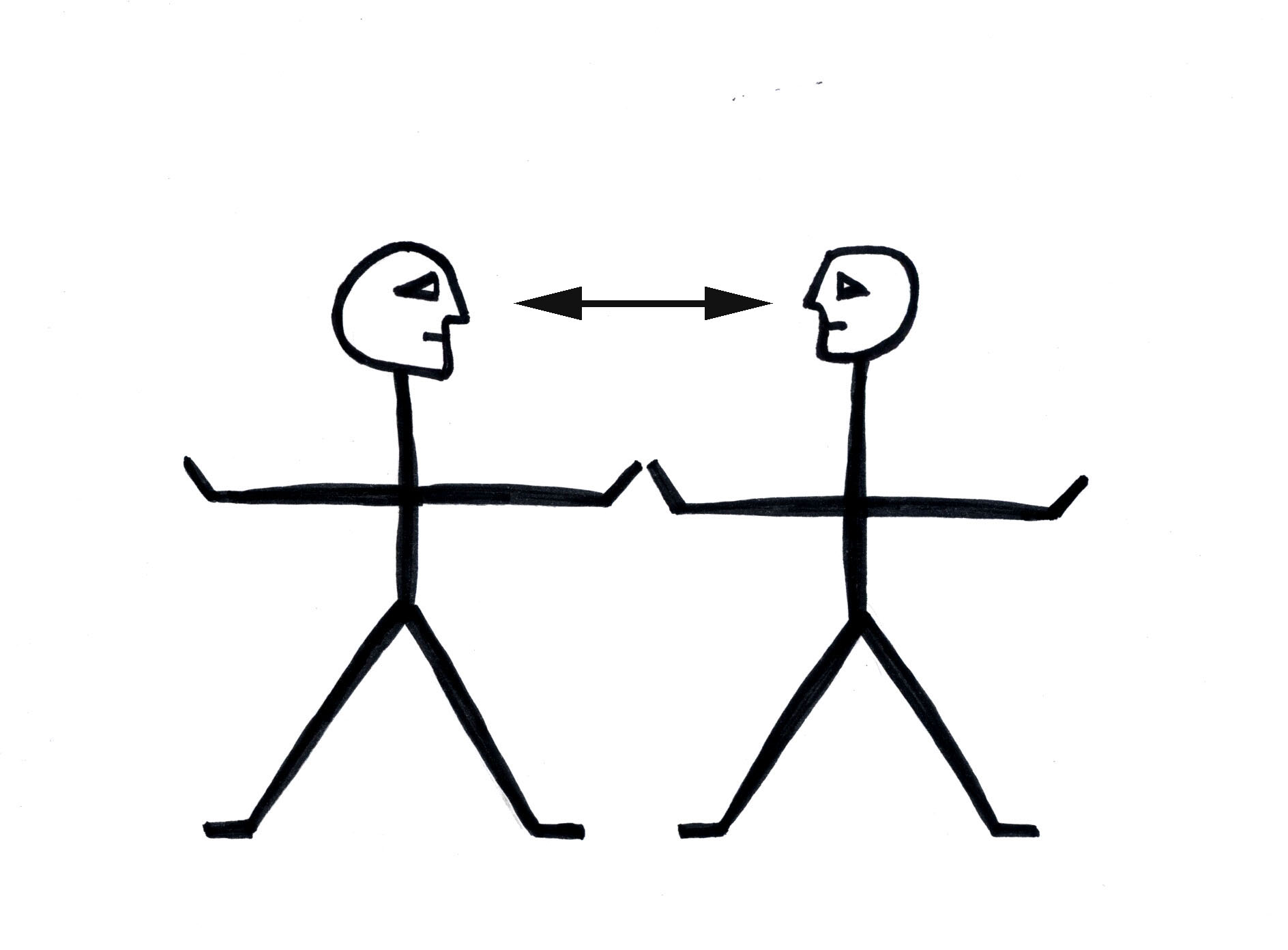 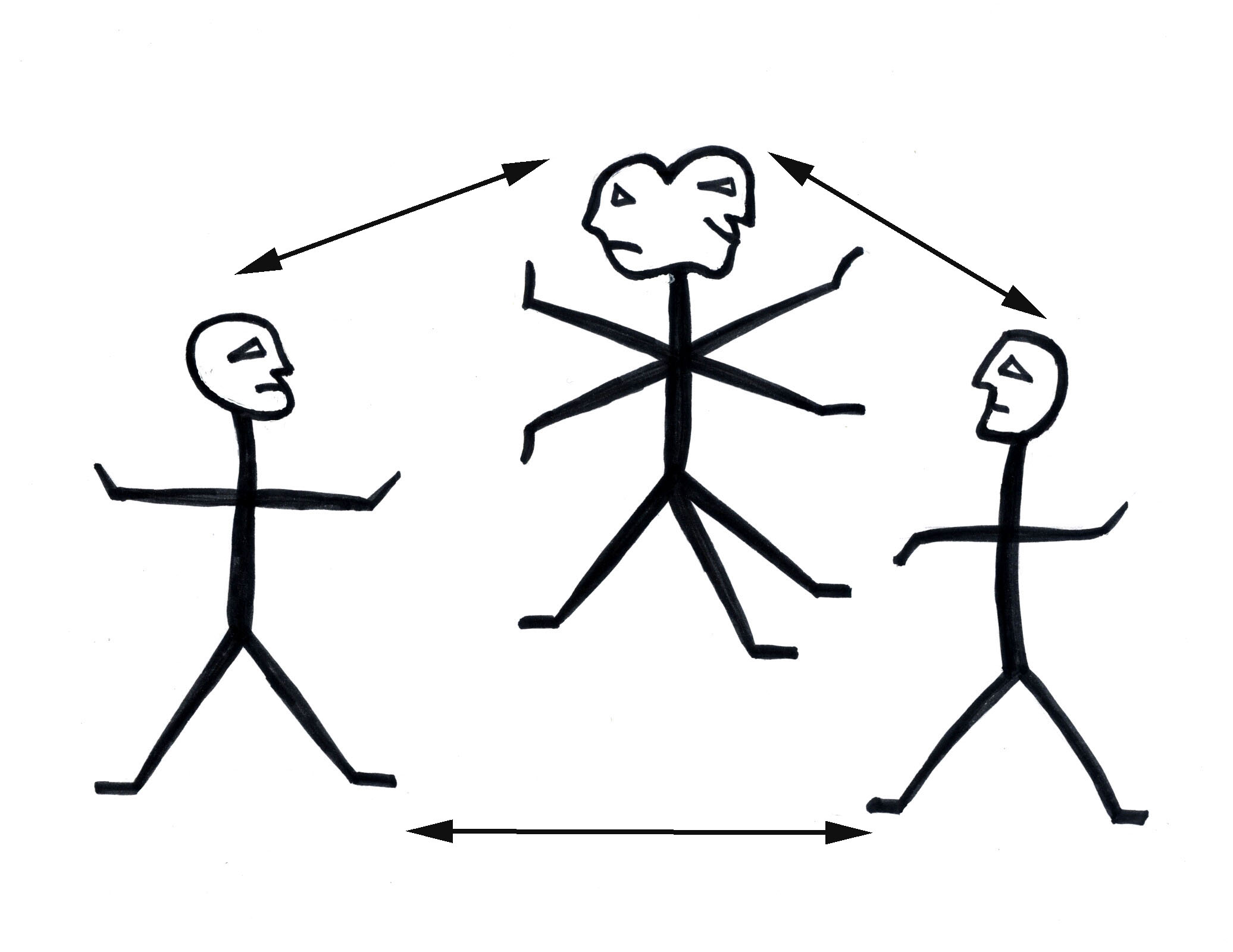
Similarly, larger groups, like families, corporations, and governments, might appear to be strictly hierarchical structures with absolute command and control networks. But in actual operation, these tend to be complex systems whose network operations arise from more distributed connectivity and interdependency. Appearances are deceiving
Despite hierarchical design, real world systems tend to self-organize emergently, through distributed connectivity: 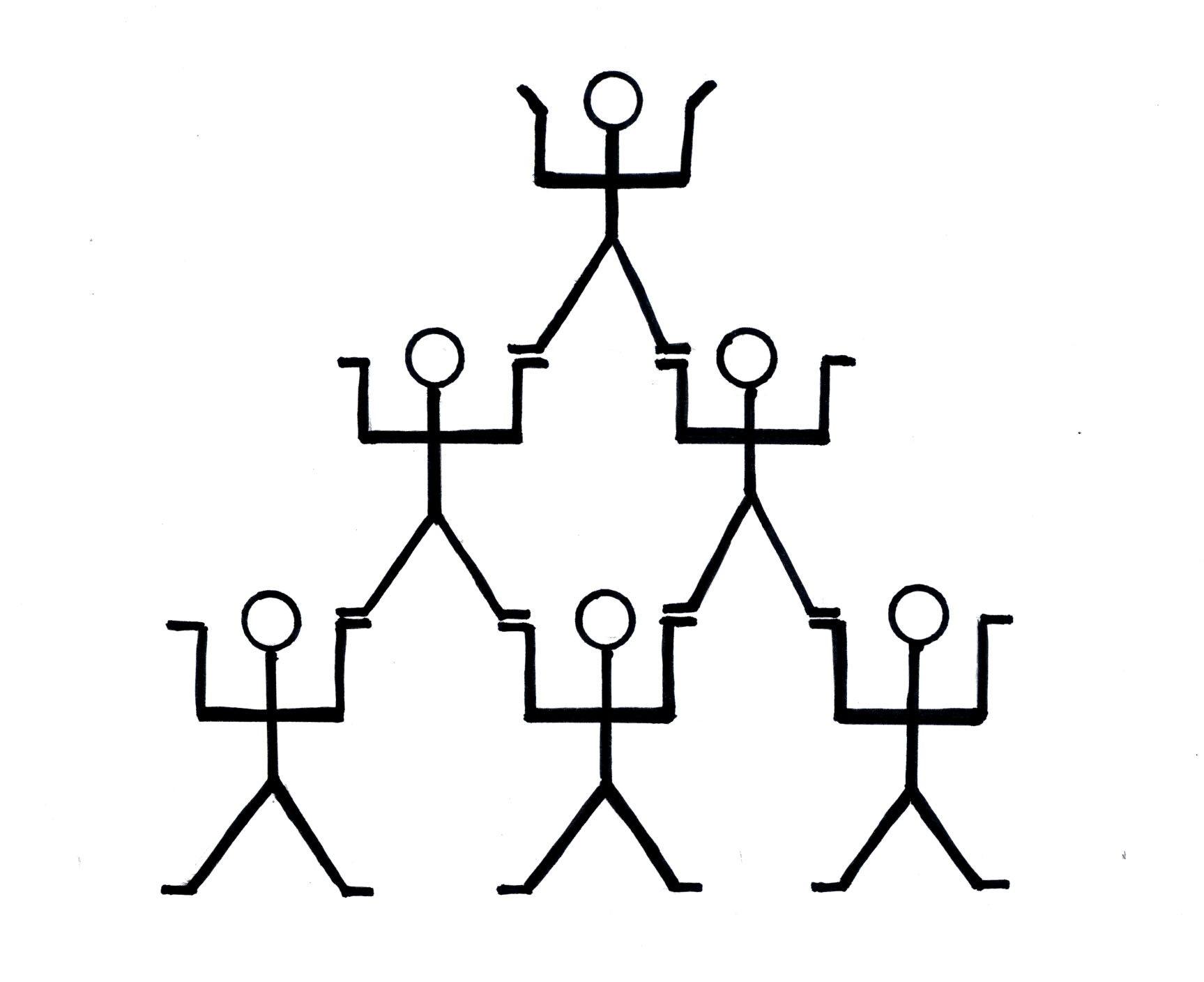 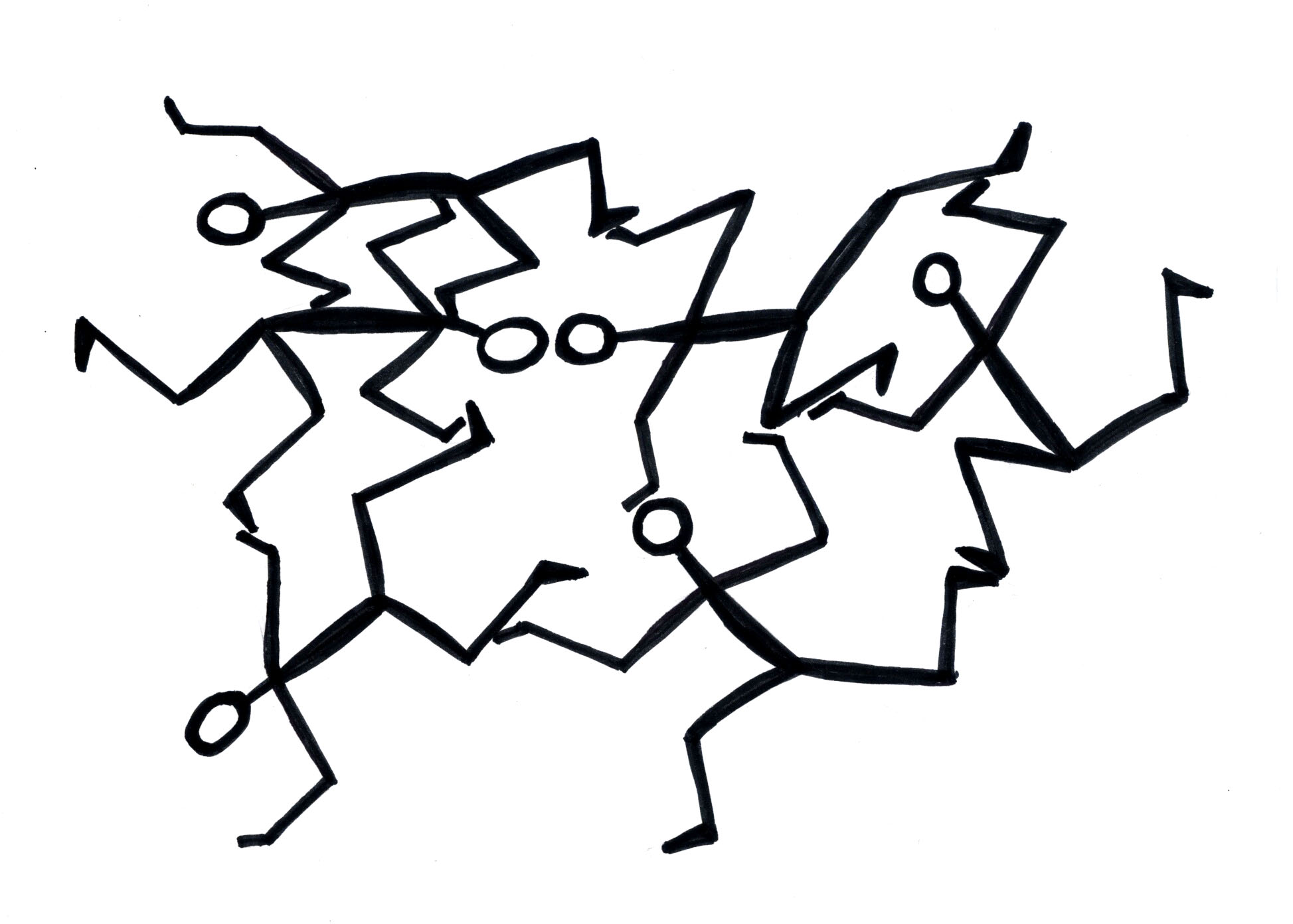
Our
human proclivity for command and control over our selves and our
environments leads us to see the world in sequences of predictable,
thus controllable cause and effect. Our pragmatic interests seek the
world in hierarchies of controllable cause and effect. But network
science now cautions us
about the dangers of such presumptions. Nature is more hetero-archical
than hierarchical.
Hierarchical projection on hetero-archic reality
The competitive, control obsessed perspective of the human "ego" misperceives the patch-work dynamics by which Nature actually acts:  Here it is worthwhile to remember that what we can directly perceive of a complex system is not its operational network. What is accessible to our perception, even under the microscope, is not a complex system's dynamical interdependency. The familiar singularity of entities that are in fact manifestations of complex networks, whether a person, a forest, or a city, is an illusion. What makes these the way they are is hidden from our ordinary awareness, partly because we do not practice "seeing" them as networks and partly because their dynamics are effectively ephemeral. What is evident is not all there is Nature's complex adaptive system networks create the majority of order in and around us--but remain effectively invisible to direct observation and calculation:   The Logic of Ordering Out of No-Where: The Betwixt and Between of Network Self-Organization The contrast between the predictably structured ordering of mechanically linear dynamics and the seemingly anti-structural order creation of complexity's nonlinear ones gives the impression that the latter "comes out of nowhere." The absence or progressively proportional causal sequences leaves us with no causal path to follow. There is no specific origin or trajectory to the events that result in emergent properties and self-organizing networks. De-centered and distributed network models assist in imaging a field of interactivity between system parts, and systems, as a kind of spatial zone of emergent causation. But this is a betwixt and between place without a chronological sequence. Many events are occurring all at once but we cannot account for all of them in physical terms. Much of the feedback involved is constituted by the processing of abstract information that does not have concrete physical properties. Thus the ordering that results does not happen either in specificable places or times, and so has not center or structural hierarchy. It "takes place" in what can be termed a metaxy, a placeless place of in-betweenness of interactions among systems parts and the system's external environment. It is not even defined by evident system boundaries because inputs and outputs are continually flowing between the system and its environment of other systems. This external field of in-betweenness effectively extends a systems network beyond itself, which leads to the nesting of multiple systems into the emergence of larger scale meta-systems. Where then can we locate the nexus of control over the operations of a complex network? It has no single center and seems to be everywhere and no where. If appears to have immaterial aspects, like a thought or idea, yet clearly has causal effects on the physical world by organizing and re-organizing its forms "at will." Network operations change their systems and that changes their environments and that prompts network changes and round and round it goes. However, returning to network modeling, that is just what we see in the connectivity of de-centered and distributive network structure: continual flows of interdependent feedback with no beginning, middle, or end. It is logical that the network self-organization this ultimately undefinable metaxy that is "neither here nor there." Despite our inability to de-construct the resulting dynamics as causal sequences, if we aim to have a sense of how the world actually works, we must derive some sense of how this activity "does what it does" without having a center or even being an identifiable "thing." Like it or not, this unstructured phenomena generates more and new structure, indeed most of the biosphere's structure. That is profoundly important. The Logic of Networks Beyond Control: The Logical Independence of Network Autonomy Complex adaptive systems are distinguished not only by their unpredictable emergent creativity but the impossibility of deliberately controlling their operations. It is one thing to influence or to some degree manipulate those operations but quite another to take control of these. Again returning to the basic modeling of network structures and dynamics, it becomes obvious why this is true. In so far as emergent causation and self-organization have no distinct structure or sequencing, there is can be no way to directly manipulate and control their operations. In network science, it is logical that there can be no way to directly control network autonomy as we do mechanical systems. This is because there is no predictive structure, no mechanisms, to control. Complex networks are beyond control. But attempting to do so certainly has effects on the capacity of complex networks to maintain their self-organizing, self-sustaining operations. Our technological powers enable us to exert massive influences on complex networks, as we do the human body/mind system through medications and surgery, or ecosystems with deforestation, damming rivers, agriculture, mining, and urban development. Such manipulations gain us short term advantages, but as we are now learning worldwide, the effects on natural systems are creating overwhelming problems for them, and thus ourselves. We seek control over natural systems, as we do our human generated ones. But even our human systems have proved to be far more complex than we understand. Network modeling involves highly specialized mathematical techniques that reveal the nonlinear dynamics involved. This mathematical analysis assists in confirming the unpredictable effects of network autonomy and documents the impacts of human manipulations on natural systems. One concept involved is that of tipping point. Complex system self-regulation is paradoxically both impressively robust in the face of environmental changes over time yet also surprisingly vulnerable to the slow accumulation of interference in the reciprocal flow of feedback between system parts and nested systems. Human activities change environments at speeds and in degrees that readily disrupt the capacity of natural systems to adapt to the effects. Effects like the introduction of massive levels of phospherous fertilized to ecosystems from farming or CO2 gases from fossil fuel burning into the climate systems gradually build up interference in the feedback of inputs and outputs in those systems. Eventually these effects finally overwhelm network autonomy, creating what is termed a tipping point. The term indicates that a system is pushed beyond its dynamical domain of self-organizing criticality near the edge of chaos and "tips over" into chaotic dynamics. The result is termed cascading collapse. There is no "turning back" once a tipping point is reached. Systems subsequently become highly irregular and often disintegrate all together. The failure of one system can lead to the collapse of an entire meta-system network in a domino effect. Eventually new forms of systems will regenerate through the emergence of new meta-system networks, but only if there a few survive to form the basis of the regeneration of complexity. Large scale examples of this are found in mass extinctions, such as that of the dinosaurs, and in human social revolutions resulting in the collapse of political and economic institutions. Currently in the 21st century, human activities have been documented as producing these dramatic tipping points across global ecologies and the entire planetary climate system. Believe it or not, from the perspective of network science, we have disabled the self-organizing network autonomy in natural systems at a speed and to a degree that has almost no precedent in the geological record. The future will be, at best, wildly unpredictable and erratic. The Logic of Network Autonomy Being the Minding of Matter The thought that network self-organization emerges "out of nowhere" yet orders the biosphere is unsettling to our mechanistic perspective. If it does so a manner similar to how immaterial thoughts or ideas can have physical effects by prompting human actions, it is tempting to think of it as a form of "minding" in Nature. When it comes to the mental system aspect of a person, this can seem like an overtly top-down command and control operation, as in "I do what I tell myself to do." However, the physical brain system and network from which mental activities emerge is itself a network of interdependent, mutually modifying networks. The brain areas associated with logical reasoning and emotional feeling are significantly independent yet also have been shown to be interdependent in facilitating each other. The nuerolgical network structure of the human brain is so complex it is regarded by some as the most complex entity in the known universe. But what then of the mind that emerges from it? Psychological analysis reveals that mental activity has a similarly diversified composition, with many mutually modifying, often conflicting relationships, the conflicted co-operation of which collectively constitute its ever variable totality. Though standard definitions of causality based on physics lead us to assume that our mental systems must be directly derived from the properties of matter and energy, network science puts this assumption logically in doubt. Furthermore, despite many serious efforts to prove that mental activity is identical with physiological brain activity, compelling evidence for this idea has not resulted. Similarly, attempts to duplicate human mental capacities using computational machinery, as artificial intelligence, have not been even remotely successful. But if mind-ing is not "in the brain," where and what is it? And is this ability to interpret abstract information and respond to it by creating new forms of organization, of invention, and willfully acting to create it, exclusive to humans, or animals? From the perspective of complex adaptive systems science, human mental operations appear as yet one more, if perhaps the most extreme, case of higher level network autonomy arising emergently as self-organizing criticality from a the radical interdependency of a system operating near the edge of chaos. The brain constitutes the physical meta-system of a collective collective of sub-systems, each with significant network autonomy, whose simultaneously interactive, mutually modifying interdependencies emergently generate a higher level network operation--which we call mind or consciousness. Just as with other natural systems, this higher level network is not the same as the physical system from which it emerges, despite the fact that it can be shown to influence the activities of that system in turn. Brain and mind are two differentiable yet interdependent meta-systems. The minding of matter
"Lower level" interdependencies in the material brain emergently generate the "higher level" psychic system, whose network autonomy in turn influences that of the brain--forming a meta-system: 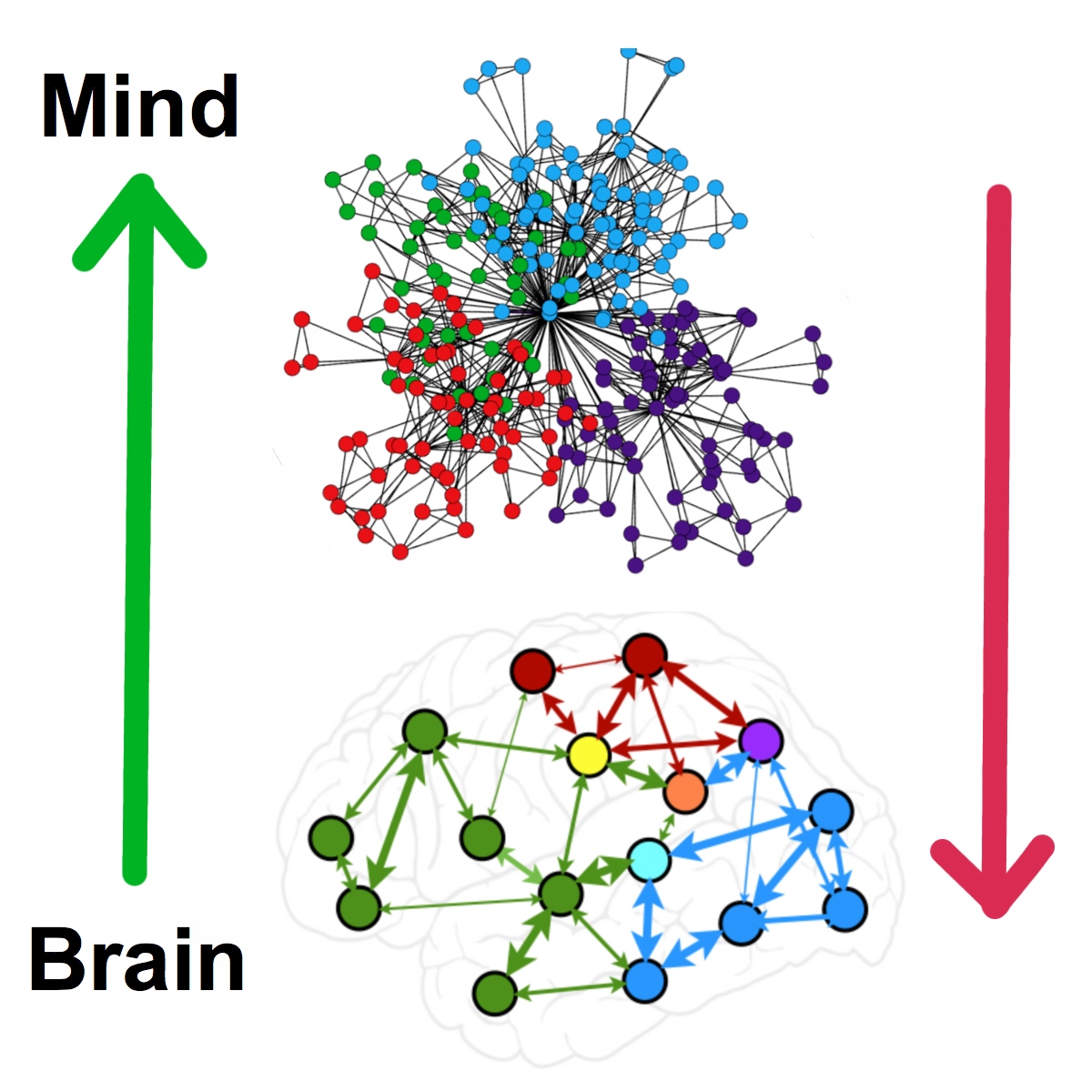 
Thus there is indeed scientific evidence to regard physical matter as the basis for the emergence of mind as a more than material, and indeed, other than mechanical phenomena. This evidence is derives not only from our inability to reduce human thought to physiological brain activity. It is found across the spectrum of complex adaptive system networks in Nature. The evident criteria for this pervasive, if ultimately mysterious, emergence of an at least partly immaterial network agency is the presence of sufficient dynamical complexity--a complex network manifesting self-organizing criticality. In this regard, the evidently extreme agency and intelligence of human mental networks associates with a similarly extreme level of complexity in the physical system from which it emerges, meaning the brain. Mind in this view equates with the general concept of emergent network autonomy across the vast diversity of complex adaptive systems. There is reason then to associate the characteristics of network autonomy in a single cell organism, a forest ecology, and a human, as a single category of phenomena. Different as these seem, network analysis shows them to constitute a spectrum of effects or properties that can be scaled up through increased system and network complexity--reaching their evident extreme in humans. The differences between "us and them" appear to be more a matter of degree or scale of complexity. This notion of scalable capacity for autonomous behavior and intelligence suggests that there is some form of consciousness active in systems that are not composed with central nervous systems and brains. Even in regard to humans, there is much argument about just what consciousness is and even whether volitional free will exists. Evidence from brain research indicates that most of cognitive mental activity in humans is "un-conscious," in the sense that one is not overtly self-aware of most of what one is thinking and even feeling at any given time. There are further indications that what we regard as self-conscious decisions might actually be determined in a pre-conscious manner, meaning through cognitive operations that occur prior to one overtly knowing one has made a decision to act. Such evidence is cited to argue that we do not actually have volitional free will. From the perspective of network science, network autonomy appears as an empirical fact detectable in even non-living systems, judging from its quantifiable effects, despite the limitations on describing and thus explaining its emergent dynamics. This suggests it need not be overtly self-conscious in the manner we experience it. Thus, even if human mental networks operate in a largely un-self-conscious manner, meaning below a threshold of overt awareness that these are happening, that fact does not disprove that such networks manifest autonomous self-organization and thus volitional behavior. Psychological analysis was created with Freud's theory of a conflicted domain of mind that has been repressed "below the level" of overt self-awareness, yet exerts pervasive influence over every person's behavior. Such observations of a sub-conscious autonomy are commensurate with network science: volitional network autonomy does not require a brain, much less demonstrable self-reflective awareness that an entity is deliberately making decisions. Thus it seems logical that the overtly self-reflective awareness of human mental networks is just one more emergent property of complex network autonomy, rather than being a definition of it. During sleep, our overt self-awareness is not evident, yet our mental networks continue to manifest autonomous creativity in the form of dreaming. So what ever consciousness, human mental networks have the archetypal traits of network autonomy as it apperas throughout natural systems. Thus there is reason to conclude that network autonomy constitutes "the minding of matter" in a scalable manner. As a basic emergent property of complex systems its effects on system behavior appear across a stunning variety of systems, animating each in characteristic ways. But it can arise with additional emergent properties deriving from additional complexity in particular types system networks. From it is "at work" from the self-organization of ecosystems to the super organisms of ant colonies, and single cell plants to the vastly amplified complexity of human brain/mind meta-system networks. The more complexity that a system can manifest, the more potential there appears to be for elaboration of its emergent properties of information processing. The scaled up complexity of animal systems associates with what we recognize as volitional intelligence. The greater a type of system's complexity, the more likely it seems to be to produce individualized versions of its characteristic autonomy of these. Individual ant behavior is difficult to identify but different humans tend to manifest differentiated qualities of human mental network operations. Whatever consciousness is, evidence for network autonomy and its variable qualities of volitional action that animate complex systems throughout Nature is compelling. The Logic of Archetypal Dynamics in Network Operations The most basic archetypal traits of network dynamics
Archetypal Mechanism Archetypal Complexity A basic electrical circuit network: A complex social network:   Diversity is an essential quality of complex systems. Different types of parts with different properties and various configurations of connectivity are required to generate their complex dynamics, and thus their particularized network autonomy. These differences necessarily involve elements of conflict between parts and their actions. Thus contrast and potential conflict appear essential to the emergence of self-organizing operations of network autonomy. The latter is not produced by systems of composed of similar parts that act on each other in hierarchically sequenced, dependently predictably, proportionally consistent ways, as in machinery. This diversified basis for network emergence has some pre-existent references for how it takes form. There are recognizable types of systems we can distinguish by both their structure and activity--or behavior. There are systems with primarily simple linear dynamics whose parts act upon each other in predictable ways, such a mechanical ones. Then there are systems with complex nonlinear dynamical properties whose parts act on each other in unpredictable yet order-creating ways. We can think of these a two fundamental types or "arches," meaning an original form. Thus we can think of the basic types of systems such as animals and ecosystems, then more particular ones such as birds and deserts. Complex systems are especially prone to exhibiting variations of both form and dynamical patterns of activity, or network behavior. No two complex systems are identical. There are many types of bird species with particular behaviors, many types of desert ecologies. This variability extends down to each individualized system. Pelicans are recognizably similar manifestations of their species type, but each individual manifests some aspects of uniqueness. High elevation deserts tend to share some traits of form and function, but each is somewhat different. This variability on a theme appears logically consistent with their basis of diversified parts producing partly conflicted or disorderly interactions that are also interdependently interactive--which are the source of their emergent self-organizing network operations. It makes sense that these aspects of system configuration and activity result in their dynamic variability over time, as they self-organize and re-self-organize in response to changes within and outside of their boundaries. This on-going variable behavior means they are not identical to themselves from moment to moment and can even undergo dramatic reconfiguration yet still be identifiable as a type of system or network behavior. Thus we can think of systems as having traits that characterize both their general type and their individualized expression of that type, both their forms and behaviors, even their unpredictable yet characteristic behaviors. We cannot predict what a particular bird species or single bird will do next, but we can get a general sense of how these types of systems tend to take form and behave through their network self-organization. These characterizing traits can be thought of as archetypal, in that there constitute ranges of characteristic behaviors associated with a type, rather than definitive categories. There is a typology of network formation and behavior, but it is not fully predictive. Complex systems and their emergent networks have archetypal character, both generally and also specific to each type of system and each individualized manifestation of that system type. An animal species is not a fixed thing but a collection of characteristic behaviors which, though recognizable over time, are also constantly variable and adaptive through their archetypal network autonomy. Whales are a type of animal system that manifests as various sub-species with distinctive traits. Individual whales of a given sub-species can be distinguished by physical and behavioral traits. This individualization of basic types of systems is evidence of the infinite creative capacity of complexity, acting within the constraints of the Laws of Physics, but not evidently bound by these in terms of how it creates such diversity of original forms of organization of systems. Different types of trees branch in distinctive patterns. Maple tress are identifiable by their archtypal patterning of branching. But no two maples branch in exactly the same pattern. There is an impetus toward maple branching, but every individual maple tree network autonomously directs its particular version of that impetus. A given system can manifest with a variety of archetypal traits, which, taken together, characterize the individuality of its particular system formation and operational network autonomy--or behavior. A city might be structured and function in an more archetypally hierarchical manner, with a distinct center and well regulated traffic, while another might have no identifiable center and chaotically unregulated traffic. Both are archetypally cities but express that type with different archetypal traits of configuration and operation. So the dynamical processes that create systems and their emergent networks can be thought of as archetypal tendencies of formation and self-organization--types of ways that things happen in a world of complex systems. These are both physically formal and dynamically behavioral. A humpback whale is an expression of the archetypal tendency to form such a system. The operqtional network autonomy of such a system has archetypal character. But a given individual manifests that tendency in somewhat unique ways, as a particularized expression of the range of potential in the general archetypal tendencies of the humpback system formation. Thus the archetypal character is expressed both by the general tendency and its particular manifestations. One humpback might be more aggressive than another. Such behavioral traits lead us to the notion of the psychology of network autonomy. Given this view of archetypal traits of formation and dynamical tendencies, network autonomy can be regarded as having particularized qualities of self-organizing impetus that are both generalized and particularized. This archetypal character of any given network constitutes the personality or its autonomous behavior. The Logic of Networked Reality: Complex Network Autonomy Animates Self and World These basic aspects of network structure and dynamics provide the scientific basis for a radical shift in our understanding of reality. We have been taught a basic contrast between mechanically orderly and disorderly dynamics. But now we see that there is not simply a spectrum from ordered to disordered, from predictably deterministic to unpredictably random. There are also dynamical conditions that deterministically create order out of significant disorder--and do so unpredictably. Similarly, standard physics-based scientific explanation describes the universe as progressively less ordered or entropic, according to the Second Law of Thermodynamics. Overall the universe is viewed as inevitably, inexorably, becoming more disorganized and random. However, complexity has been shown to generate new and likely infinitely variable forms of organization, despite the assumed entropic trajectory of the universe as a whole. The evidence suggests that Nature has some innate impulse toward creating greater and more diverse forms of emergent complexity. This fact further confounds our efforts to explain how such additional ordering is created. From the explanatory perspective of physics, it "should not" be happening. Thus arises the notion that there are actually two different modalities of order creation, that of the Laws of Physics and that of complexity's emergence and self-organizing systems. Though causally different, these two types of order creation must also be co-arising phenomena of Nature. Needless to say, this is not a popular concept in the realm of contemporary science. Nonetheless, we are confronted by compelling evidence that things happen in ways we can't fully understand. Despite the knowledge provided by network science, we are left without any scientific means of fully analyzing the causal creativity of complexity. How are we to think about it in ways that give us further insight into its crucial role in our existence? How are we to "see" the world "the way it actually happens"--as neto-logical reality? It is evident that this creation of order out of disorder turns out to be the source of most of the form and organization that makes up our selves and the biosphere around us. Through a vast unplanned, interdependent interplay of simultaneous, partly chaotic flows of outputs and inputs, acting as feedback within and between systems, networks form that imporvisationally self-organize to generate otherwise impossible variations of complexity and novelty. Species evolution could not occur without this emergent creativity, if only because the behavior its autonomous networks create influences the environments within which natural selections occurs. In the logic of networks, it takes disorder to generate the complexity that can emergently create networks that act autonomously and purposefully to produce the manifest complexity of forms and behaviors that constitute humans and the world we inhabit. At varying scales of larger and larger meta-networks, network autonomy processes information about its systems and their environments in ways that equate to a form of thinking. Subsequently they act as if alive, whether or not they are composed as biological entities. Furthermore, nearly every thing one encounters has in some way been influenced by the self-organizing autonomous networks of complex adaptive systems over eons of time. We exist in an oxygen rich atmosphere because of the complex adaptive systems of plants, whose particular archetypal mode of operation utilizes the in-put of carbon dioxide and generates the the out-put of oxygen. That out-put enabled the evolution of the archetypal typology of animals, whose systems use it as input to their operations. And that oxygen has myriad chemical effects even on the geology and meteorology of the physical planet. A house is a specifiable physical structure that an be explained in the terms of deterministic physics. But this analysis tells us nothing about how it came to have its form. That is a product of autonomous network intentionality. A plane flies according to the laws of physics but it only exists, thus flies, because network autonomy emergently organized its mechanical system parts into its form and the function of flight. Complexity may be an emergent property of physics, but its autonomous networks have the capacity to organize physical matter and energy in ways that could not exist otherwise. Those emergent properties become part of the physical world that in turn is the material from which complexity generates yet further emergent properties. Network autonomy gives form and function to the physical systems from whose interdpendent dynamics it emerges. It effectively makes these animate entities with volition and archetypally characteristic behavior. The Logic of Network Character: The Archetypal Traits of En-spiriting Information in Network Self-Animation The archetypal diversity of autonomous system networks and their reciprocal interdependency is the creative basis of the biosphere. The archetypal tendencies of forming and behavior we can identify across this vast networking of networks are the expression of each system's autonomous self-organization that effectively animates that system by directing, and re-directing the behavior of its parts as it interprets information about itself and its environment in each moment of time. Furthermore, these networks accomplish this by incorporating information about their history to act willfully, with the teleologically purpose of preserving or adapting their system for sustained survival. Thus we can regard our selves and other complex adaptive systems as intentionally self-animating entities whose interplay animates the biosphere as a collective meta-network. that are identifiable by our archetypal characteristics. Though we cannot analytically determine exactly how these networks function, we can differentiate aspects of their dynamical behaviors as tendencies to manifest types of form and activity--their archetypal character. These archetypal tendencies have a history in the emergence of past system networks that present one can somehow improvisationally re-generate from the partial instability of each present moment. Systems somehow use this information in establishing their particular manifestation of their type of archetypal forming and behavior. But by doing so in an individualized way, combining element in various and novels ways, each adds some ela boration to the tendency, and that variation on a theme can become relevant information to the operations of other systems. In biological systems there is an evident storage for historical system forms and operations in genetic encoding, though this information must be accessed and interpreted by emergent network operations relative to its systems current conditions. And much of network operations in animal systems derives from learning by interpretation of interaction with other systems and environments. But many complex adaptive systems, such as ecologies and cities, are not constituted with either an encoded genetic memory nor a central nervous system and brain. Nonetheless, these generate form and behavior having archetypal character related to others of their general type which cannot be predicted or explained in the terms of mechanistic physics. Again, the physical structures of cities and forests can be fully analyzed and explained, but now how these came to be organized in the way they are. Their actual network self-organization remains a black box of dynamical activity into which we have not scientific perception. In manifesting typical yet variable patterns of archetypal character, both animal systems and non-living ones give the impression that their pattern creation of from and behavior is being influenced by past tendencies. It is as if there are originating types of formation and behavior that influence how things take shape. These types of forming tendencies are neither fully deterministic nor explanatory. They are only descriptive. In addition, such tendencies evolve over time through emergence of variable versions. They taking on new traits while often remaining identifiable, whether as succeeding generations of a family line of humans, a species of frogs, or the successive reconstructions of a city. It is at this point that attempts to understand such phenomena prompt the notion that the network self-organization that effectively animates the systems of the biosphere is in some manner in-formed or guided by what, for lack of a more scientific term, seem to be the in-forming impetus of archetypal spirits. It is as if system formation and network operations are en-spirited by a diversified range of archetypal tendencies, to which each individual network gives some unique expression. In that regard, every system and network's self-organizing animation is an expression of en-spiriting archetypal information. Or rather, a whole range of diverse, even conficting archetypal traits that, manifesting interactively within and as a particular network, give it its diversified individuality as an animating spirit of archetypal information. Which is to say, a complex of archetypal tendencies configures the characteristic personality of whatever goes on inside the black box of an emergent network. As vague as it seems, it at least gives us a way to think about the ephemeral operation of network autonomy. It also assists in comprehending the correlation of network science with mythical symbolism as the metaphorical version of complex network modeling. A Netological Philosophy: Thinking Like Nature Acts through Two Types of Network Dynamics It is possible to distill a basic philosophical perspective on reality, or the way Nature acts, from the bi-dynamical knowledge of order creation in systems and their networks. There are two different ways in which forms and functions come into being, two dynamical aspects to the ways that things happen. These associate with two types of network structure and their related dynamical activity. One emphasizes the predictably deterministic, structurally consistent, progressively proportional causal processes associated with the Laws of Physics. The other emphasizes the un-predictably deterministic, structurally inconsistent, progressively disproportional events associated with complexity's emergent creativity. We might call these structurally dependent versus interdependent network dynamics. This distinction is made in regard to the contrast between structure or order that results dependently from preceding or past conditions and that which does not, but rather from the interdependency of interacting of factors in the moment . This view generates a bi-dynamical conception of order creation: the predictably mechanistic and the unpredictably emergent. Both are intimately involved in the formation of nearly all aspects of the biosphere. But that reality cannot be remotely comprehended without a sense of the differences between the two. Learning to think in terms of network structures and their related dynamics gives us a starting point to increase awareness of how things actually happen. This is necessarily an abstract effort, since not even the networks associated with mechanistic causation are overtly obvious to perception. One must conceptually take systems apart to identify the networks of even many simple mechanical systems. When it comes to complex systems, analytically taking these apart does not fully reveal the actual dynamics of there networks. Frustratingly, even for the most advanced scientific methods of analysis, complex networks remain at least partially "invisible." However, making the effort to distinguish these types of networks informs us that we are indeed confronted with the phenomena of syntergistic emergence, rather than only mechanistic determinism. As a basic philosophical tenant, this notion of reality arising from two types of network dynamics, directs us to become more constantly aware of the roles they play in our selves and the world. We are and inhabit a realm of invisible complexity. Thus it is useful to always be asking one's self just what type of systems and networks one is trying to understand or relate with. We would be wise to continually ask ourselves, "What type of networks am I looking at?" The simple contrasts in network structures are a kind of iconic reminder of these differences. Mechanistic Netology
Traits of network structure associated more with proportionally consistent structuring of predictably mechanistic events: 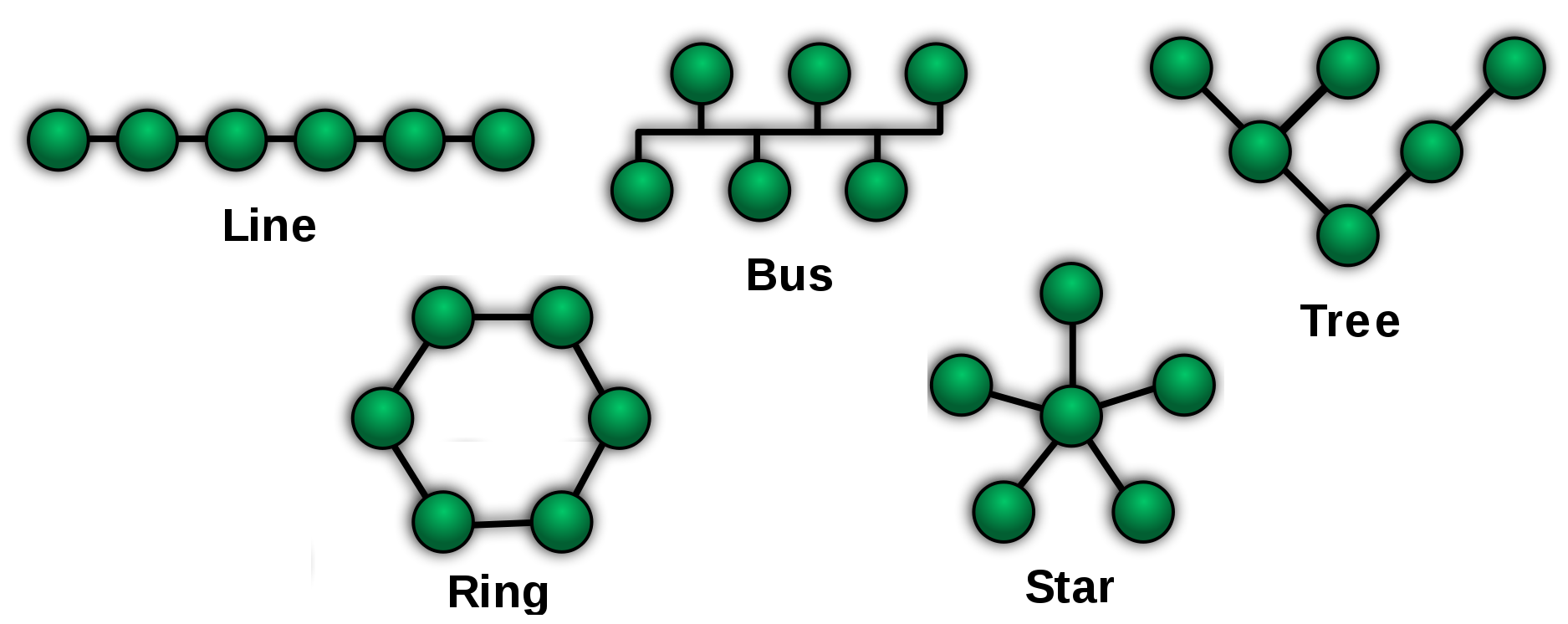 Simple sequential
icons for progressively consistent events in which each proceeds
from the previous, as in 1,2,3, or all converge in an identifiable causal process:   Complex Netology Types of network structure associated with the proportionally inconsistent structuring of unpredictably synergistic emergence: 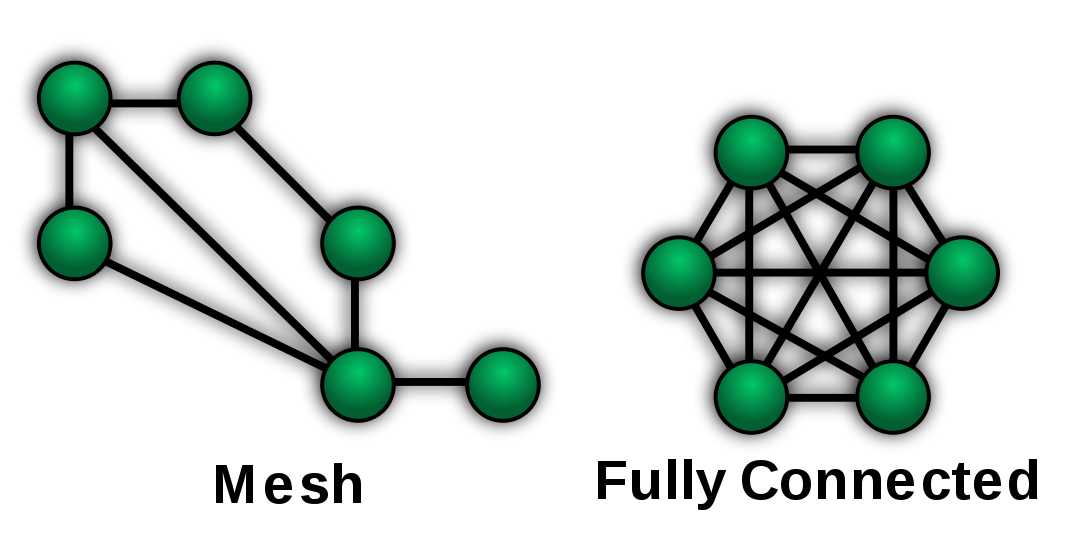   The greatest challenge comes in attempting to iconically represent the dynamics of interdependency and emergence. Somehow we must prompt ourselves to be aware of the in-betweenness of each moment's interactions among feedback flows, of an instantaneous back-and-forth that is an every-which-way and round-and-round of mutually modifying factors. Inadequate as progressive modeling is to represent such a notion, it gives us a start at conceiving the invisibility of complex network dynamics. The iconography of interdependency Graphics for suggesting the instantaneous interdependency of interactions:  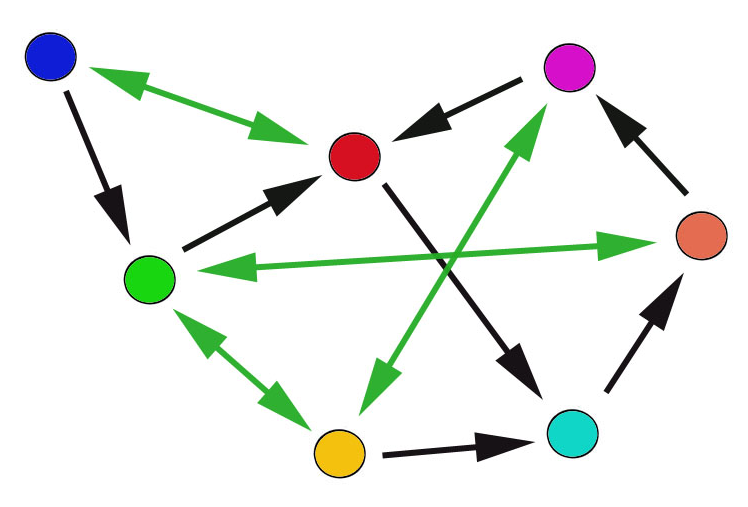  We can also attempt to represent a time sequence of moments of instantaneously interdependent interactions having disproportional consequences, as if the sequence were 3,4,2:  But to attain a more apt impression of such interdependent dynamics in each instant, and ongoing over time, we need to abandon our focus on sequences. This invisible interplay between factors is given a visualization in the the turbulent flows of interacting colored fluids between multiple vortexes, shown below. The latter represent system parts, or interacting systems, and the mixing between these the interdependency of mutually modifying network operations. The image on the left below gives an impression of a particular instant of interactive dynamics. Figuratively, it is like a snap-shot of meta-system interdependencies, with feedback influences from many interacting systems flowing out and mixing to generate the network operations of a larger meta-network. The image on the right gives a sense of the difference between predictably sequential actions and the turbulence of the ongoing evolution arising from mutually modifying interacting ones over time. The logic of disorderly ordering
Turbulent mixing and linear or laminar flow versus turbulent flow: 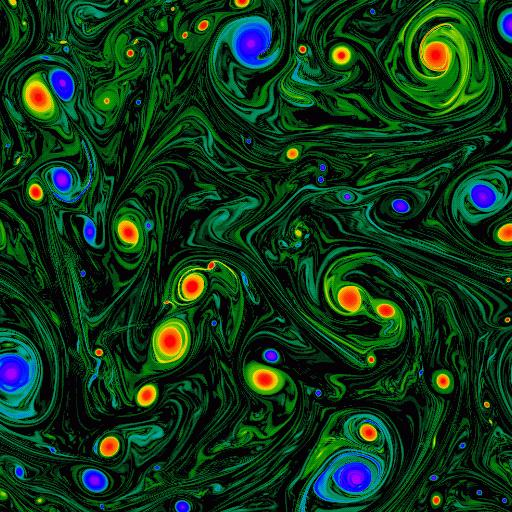 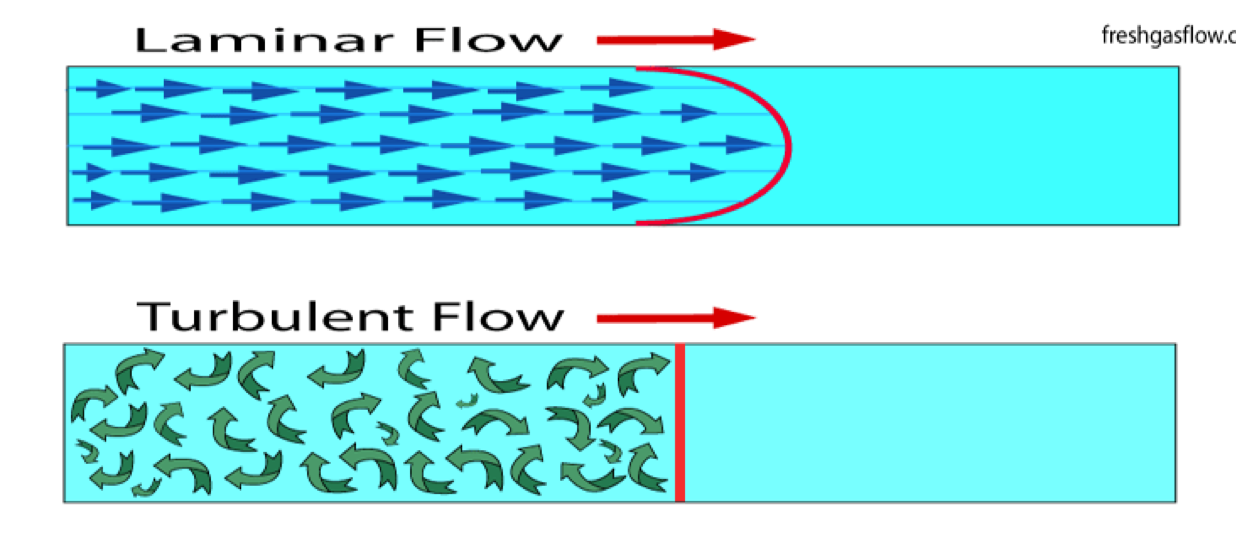 The Logical Mystery of Emergent Network Order Creation However, despite the science behind this logical notion of differentiating network dynamics as dependent versus interdependent, and the basic philosophical perspective it suggests, we are left with a kind of void. There is no conclusive empirical evidence to confirm logical speculation on just what actually happens in the in-between realm of interdependent dynamics and emergent order creation. This limitation on how precise our understanding can be is crucial to any realistic perspective on how things actually happen, and thus how Nature acts to generate the biosphere. Indeed, reasonable reflection upon what scientific method can reveal about ordered forms emerging from chaotic dynamics and self-organizing networks from complexity's state of criticality, readily prompts a sense of the miraculous. Firstly is the implication the the predictably deterministic order creation of material physics is the basis for the unpredictably deterministic order creation of complex dynamics. Secondly, there is the conundrum of this unpredictably, thus inexplicably emergent ordering to self-sustain its forms in a self-similar manner over time through self-regulation, despite perturbations, and even act willfully to adapt its forms and operations for the purpose of maintaining the existence of the system from which it emergently manifests. From the perspective of material physics, these are confounding facts. Nonetheless, most of the forms and functions we are and surround us have been shown to arise emergently. This appears illogical until once closely contemplates the differences in linear and nonlinear dynamics, in orderly order creation versus the disorderly conditions of self-organizing criticality. If the latter dynamics are creating order, then it would logically be of an inconsistent and unpredictable character, whose identifiable patterns could not be exact reiterations but only self-similar variations over time. That being the case, then the very existence of the order we are and inhabit, deriving from such dynamics, is logically mysterious. It can come into being, and be sustained, only through dynamical conditions that are inscrutable our methods of precise quantification and calculation. To exist, it must be mysterious to a mechanistically causal explanation of events and transformations. The point here is, that though such a conclusion is deeply dissatisfying to our physics-based, pragmatically control-oriented worldview, it does have a reasonable basis. And there is yet more science to elaborate this conundrum. The Logic of Networks as "Dynamical Attractor Landscapes" Scientific analysis of complex systems and their networks also expresses their diversified archetypal character through the concepts of dynamical attractors and attractor landscapes. These derive from analysis of data taken from observations and measurments of actual systems that allow for creating abstract mathematical models. Those models are represented as graphs which give us another way of visualizing the characteristic behaviors of these ultimately undefinable phenomena. Network Dynamics as Dynamical Attractors Consideration of network dynamics is aided by the abstract notion of dynamical attractors. The activity of a system over time can be measured and represented as a graph showing cycles of movement. In simple physical systems, like a swinging pendulum, the cycles appear in relation to a fixed point on the graph. That point suggests a center around which system activity "orbits," as if there were some central force controlling the actions of the system--such as the swing of a pendulum. Thus it is termed a dynamical attractor. But this location on a graph, around which the activity of a system appears to be organized, is not a literal force. It is an expression of the overall activity of the system, of the dynamical relationships between its parts that are its operational network. A simple dynamic system with a fixed attractor point
A pendulum swinging in a circle, graphs of its initial activity around a fixed attractor point at the center, then its changes as the dynamic force dissipates: 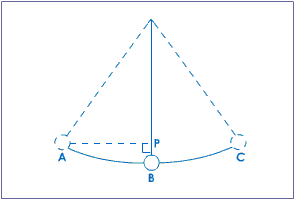 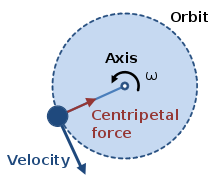  The graph of the pendulum movement indicates its attractor point by tracking the activity of the network of relationships between it parts as a system: the weight on a string, the point from which it hangs, the velocity of its initial impetus, and the centripital force of gravity resisting its momentum. This image provides a means of vizualizing or seeing the system's dynamical network, in contrast to the static network it manifests when not in motion. The swirling of water in a vortex provides another example of dynamic network relationships. The moving water interacts with the physical form of its container and the force of gravity to manifest the network of relationships we see as the vortex. Order formation in chaotic dynamics manifesting an attractor:
A vortex in water and diagram of the dynamic relationships of its network formation around an attractor point:  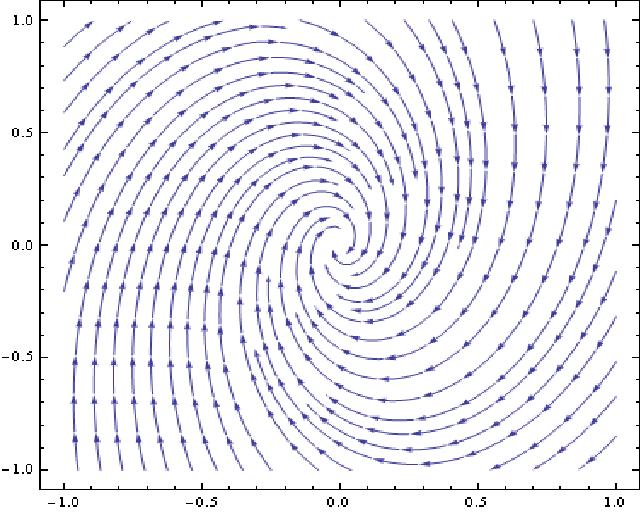 The predictable patterns of activity in systems having linear dynamics, like the pendulum, are said to manifest a "steady state" that has a "fixed point dynamical attractor." Systems whose activity repeats continuously are described as having a "limit cycle" and a "periodic attractor." The dynamical behavior of the system goes through a cycle then repeats itself. Both can be graphed in two dimensions and express a constantly positioned attractor point on a graph. But when it comes to systems having more non-linear dynamics and the disorderly ordering of chaos and complexity, their pattern formation involves many more variables. It becomes unpredictable. Representing the attractors of these systems requires three-dimensional graphing in what is termed "phase space." In effect, the attractor point of dynamic activity in such systems moves around on the graph as the system's activity changes over time, yet remains in a somewhat ordered pattern. There is no fixed point of reference yet there is recognizable similarity in the successive actions, or "phases," of the system's behavior. Yet the overall activity of the system does generate an ordered form on the graph. Systems expressing chaotic and complex dynamics tend to generate graphs with multiple, sequential, and moving attractor points. Their network of dynamic relationships is continually changing, yet remains within identifiable boundaries Such variable attractors are termed "strange" due to the unpredictable yet order creating behavior of the systems they help to describe. Systems whose activity express strange dynamical attractors never exctly repeat the same forms or patterns. Simple and complex attractor patterns
Predictable fixed point and periodic attractor patterns versus an unpredictable yet ordering strange attractor:  These mathematically derived images provide ways of visualizing different types system behaviors that arise from dynamical network relationships among system parts and external factors Types of attractor patterns
Examples of various attractor manifestations and 3D strange attractor graphs: 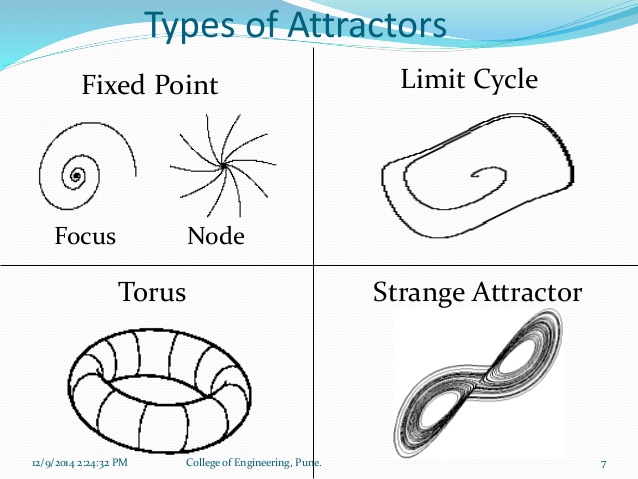 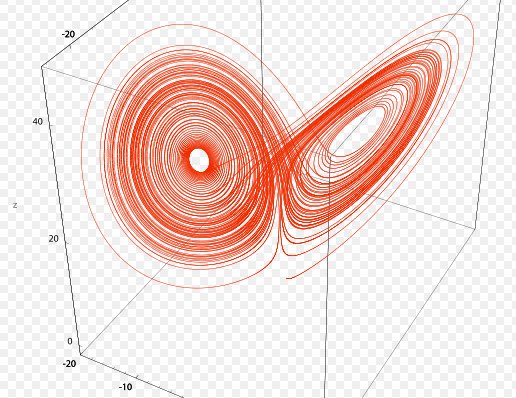 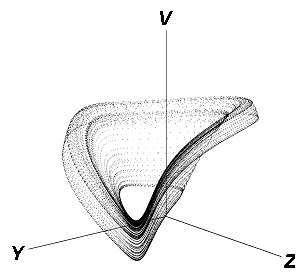 The notion of dynamical attractors poses one of "repellors." Just as there is a graphable shape that indicates an attractor point or points that appear to pull system activity toward or around it, a counter influence can be conceived that pushes or repels the system away from it. Here one can think in terms of "inner" and "outer" influences. The inner impetus arises from the configuration and activity of the system itself. The outer impetus derives from some object or activity external to the system, which influences the system by resistance to it--therefore the term "repellor." Thus when we look at a phase space map of system activity over time we can think of it as the interaction of internal system parts with each other and factors outside the system in its surrounding environment. Dynamic systems do not operate in a void but in relationships with external forces and other systems. Dynamic patterns as response to "inner and outer forces"
Diagram of a repellor and attractor interaction, and a phase space map: 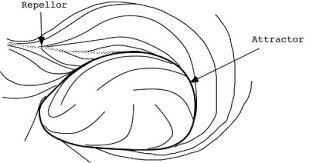  Understanding how complex systems and their dynamic networks both fluctuate and yet maintain an identifiable overall form is aided by the concept of multiple and sequential attractors. When a system is disturbed, or perturbed, its operations can change, generating a different attractor point. Then it might return to the preceding pattern of activity, or reorganize again to yet another one. This is referred to with the term "perturbation." What is distinctive about complex adaptive systems is that their networks can re-self-organize in response to perturbations. They often do so in ways that either restore the trajectory of a previous pattern or adapt to changing conditions by generating a new network of relationships, which would manifest as a different trajectory in a phase space map, with different attractor points. Here we can think of a group of jazz musicians improvising around a melody. Each player is concurrently and continually responding to the others while occasionally improvising, from which emerges the on-going pattern of their dynamic, self-determining yet unpredictable interplay. The innovation of one perturbs the existing pattern, prompting a similar yet different one as the ensemble of musicians responds to the perturbation. The ability of complex systems to respond to perturbations of their dynamic patterns while still retaining, or regaining, identifiably similar forms is referred to as "robustness." But such systems can respond to perturbation with abrupt metamorphic change as well, "leaping" to a quite different pattern of behavior in a sudden transformation. System responses to perturbations
A perturbed system moving through an attractor sequence and one making a transformative shift to very different mode of self-ordering: 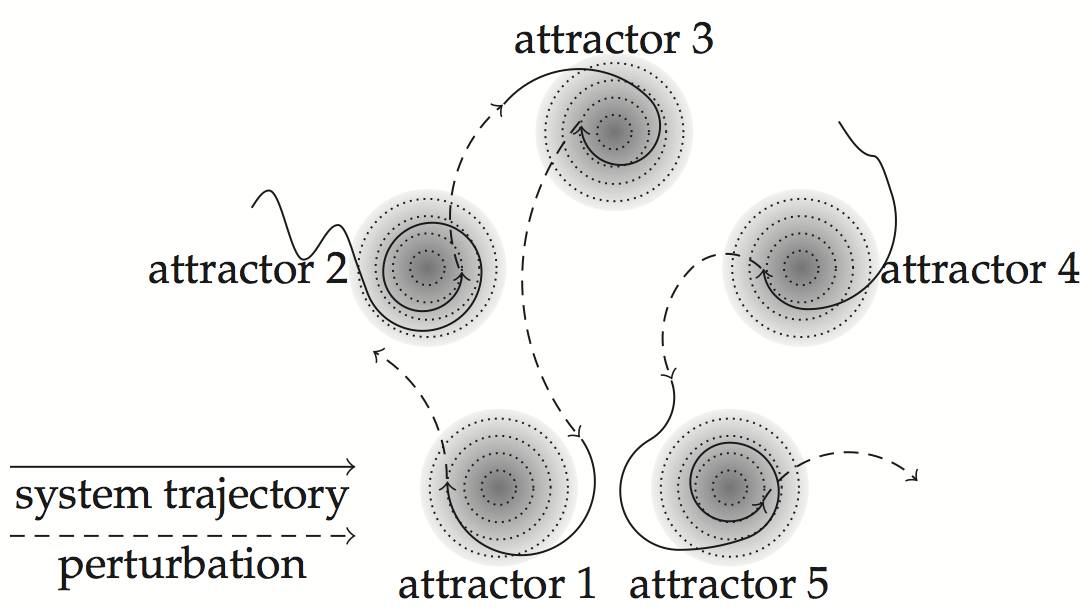 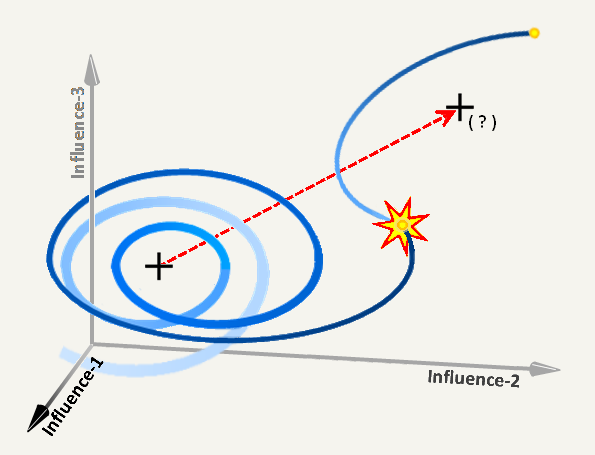 This array of abstract images helps reveal, by making "visible," the diverse archeytypal character of dynamical systems and their networks. The graphs allow us to visualize the ways their interdependent interactivity, among diverse, even conflicted elements, produces order from disorder, resulting in strange, variable, yet bounded forms and operations. But, of course, these images are not the ultimately undefinable operations of the networks that they model. In this regard, they are like the symbols of mythic imagination. Link to video animation of changing attractor landscape Archetypal forms of dynamic behavior
Examples of the range of identifying symmetries of pattern formation expressed as 3D graphs: 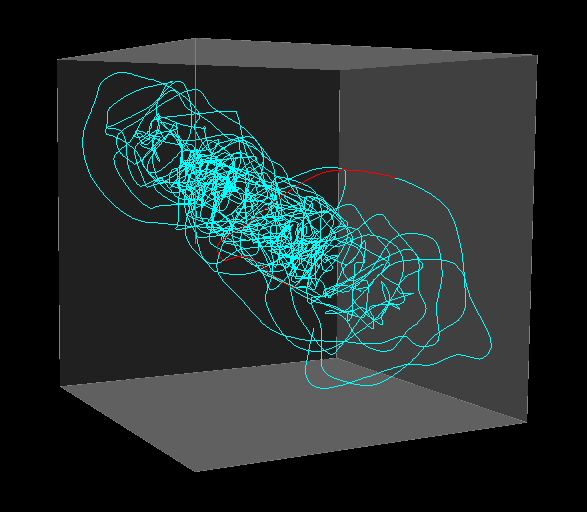 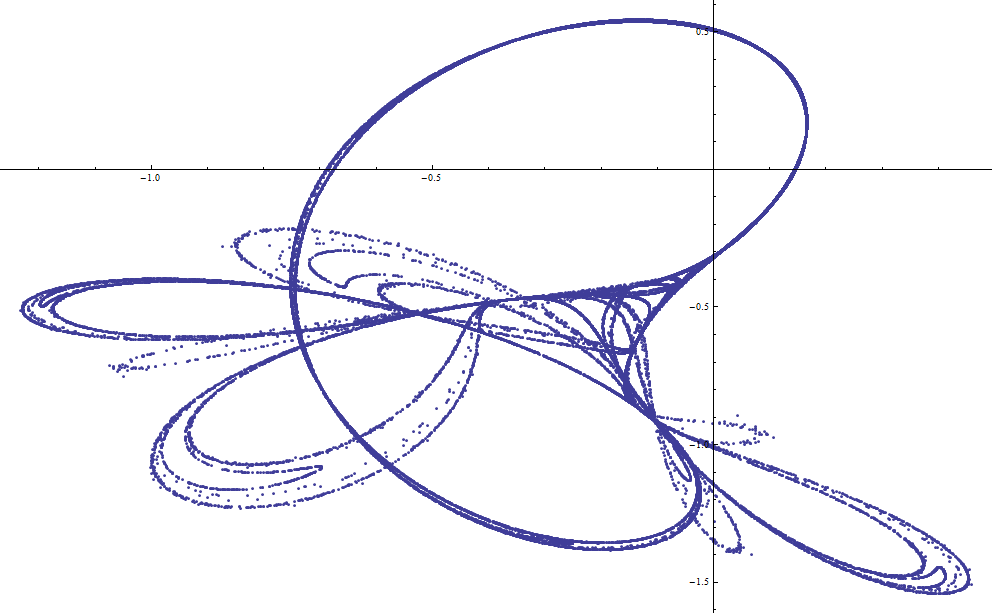 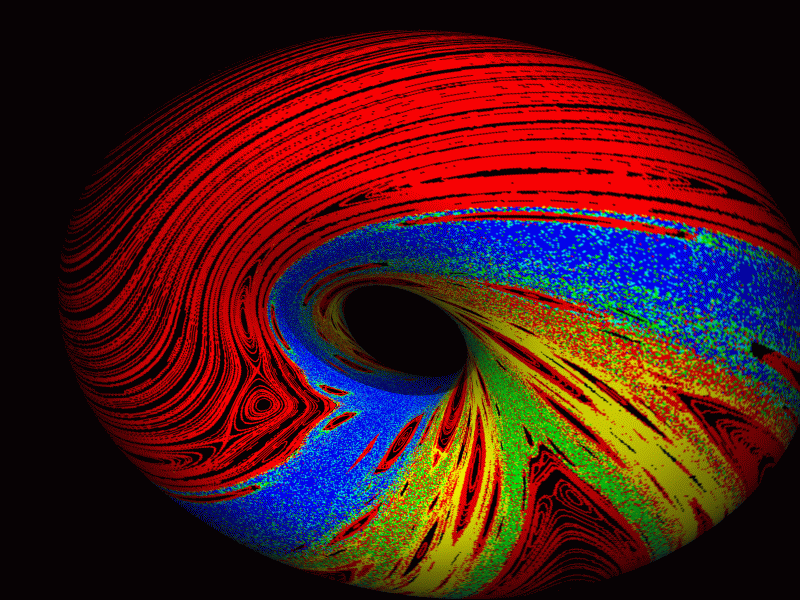 Network Dynamics In and As Dynamical Attractor Landscapes A further method for visualizing the dynamical relationships of systems and their operational networks extends to notion of attractors to include a three-dimensional topography or landscape. This provides images of what are termed attractor basins and attractor landscapes. A literal example of an attractor basin is a toilet bowl in which moving water forms a vortex. But this concept also describes the formation of dynamic system behaviors that are not directly constrained by a physical container. The shape of a basin can be an expression of a systems own internal relationships that result in its form, such as water currents interacting, or of influences from external factors, such as feedback from other systems in their local environment. Attractor expression as an external form
Ways of modeling an attractor basin on a 3D graph: 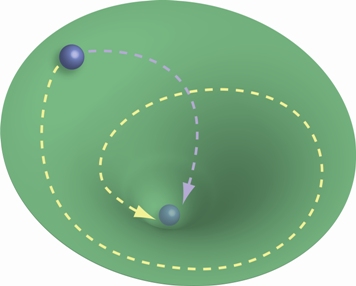 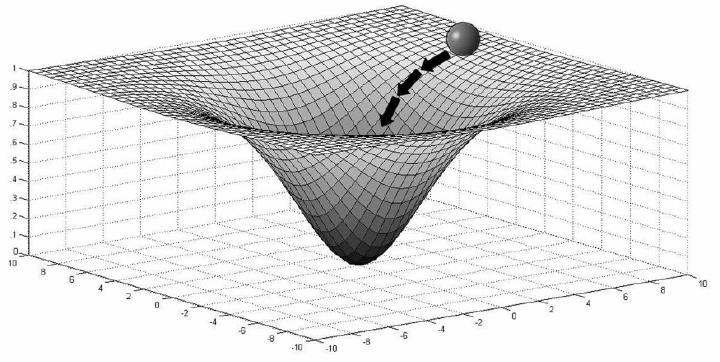 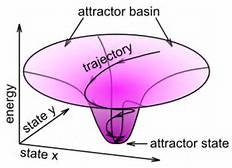 Attractor landscapes represent complexes of attractors and repellors that are expressed by, or exert influence upon, the ways a system network manifests its form and operations. Perturbations of a system's existing pattern of dynamical behavior can shift its network of dynamical relationships from one attractor basin to another on an attractor landscape. But again, these images do not necessarily represent specific physical forces. They are a way of imagining the evolving interactions within and between systems. Attractor proximity as a dynamic topology
Models of multiple attractor landscapes that influence system dynamics: 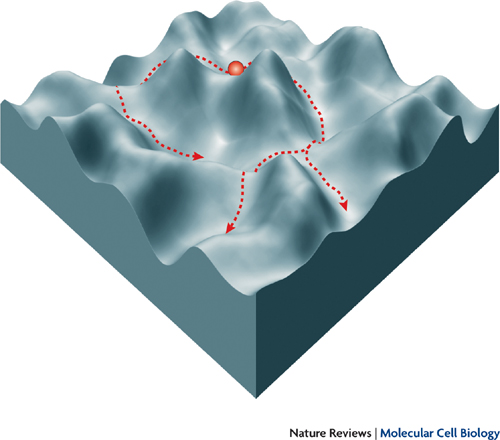 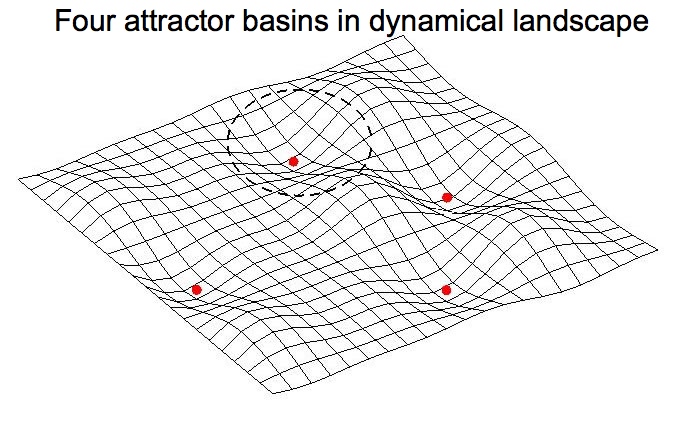 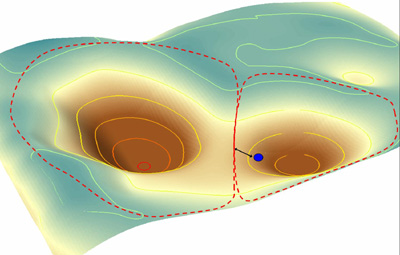 The complex dynamics in some systems express multiple attractor points. When graphed, there are several points around which the activities of the system appear to orbit or be ordered. Recall the image is of a river having many vortices and eddies, each taking on variable but similar forms simultaneously, as in the images above. These concurrently interact, influencing each other, and together constituting a meta-system and network of order creating relationships. This image provides the basis to think of a dynamical attractor landscape existing within or as a continuous system and network as a terrain or topology of attractors. The swirls in a turbulent river or numerous persons interacting as a social group express a multiplicity of differing but interacint pattern formations. These can be considered as constituting the topological traits of an attractor landscape. Conceiving how systems take form and operate through these images, as the interactions of various dynamical attractors, some of which are predictably constant and others "strangely" unpredictable, elaborate our sense of network operations. The on-going emergence of adaptive network autonomy appears somewhat more logical when one thinks in terms how complex attractors can "move about" and even "collaborate" within one system. We can then conceive of many dynamical attractors interacting as an attractor landscape manifesting from concurrent flows of feedback both within a system/network and between it and the attractors of other systems/networks. Real World Attractor Landscapes The notion of dynamical attractor landscapes is useful in understanding the ways real world systems manifest their network autonomy. A complex system like a court of justice is constituted by many different sub-systems, each with their own specific characteristics: law enforcement agencies, prosecutors, attorneys, penal systems, judges, and a diversity of laws to enforce. Both these components and the personalities of the individual persons involved in them constitute a vast array of variably competitive and cooperative interests. But they are also influenced by other systems that interact with them: legislatures, politicians, social groups, news media, cultural norms, etc. All these components and factors constitute a complex, continually fluxuating attractor landscape. Depending upon which dynamical attractors are activated at any given moment, the overall meta-system can manifest very different traits of network autonomy, of archetypal character and intentionality. And depending upon the subject of a given legal case or the status of a defendant, different dynamical attractors withing this landscape can be activated. If a defendant is identified as a member of an ethnic minority or lower ranked social class, the system is likely to behave differently than if he or she is a member of an ethnic majority or higher ranking social class. The Illogical Relations of Humans to Complex Networks: Our Obsession with Control Equals Ignorance of Network Autonomy Everything that makes us human, that constitutes the archetypal character of the human body/mind system, is arguably a property of complex network dynamics, rather than deriving only from the physical matter and energy those dynamics organize into our humanness. We are animated by our emergent networks. If we are to know our selves, much less the world, if we are to think like Nature acts, we require a form of knowledge about those dynamics. Surprisingly, the scientific knowledge we have thus far gained about them actually derives from our resistance to their implications. As humans, we adapt to our environments by manipulating them. But we do so not only through our physical abilities. We create technologies that exponentially amplify our capacities for manipulation. We exist by manipulating other natural systems, even each other, in an effort to dominate and control them for our purposes. We are archetypally "creatures of control," acting with out regard for how our behavior impacts the network autonomies of other systems. What we deem is good for us is the ultimate good. As such creatures, science represents our quest for ultimate knowledge about reality which will grant us ultimate control over everything. However, that relentless pursuit of the knowledge of control is what has generated the scientific evidence for the existence of un-controllable network autonomy. Our analytical taking things apart to understand exactly how they are constructed and happen has revealed the very limits of our ability to fully understand, much less control Nature. As logically accurate as this statement might be, it conflicts with our cultural belief about how reality logically ought to be. Despite the fact that scientific knowledge enables us to exponentially amplify our capacity to manipulate and control many aspects of our environments, these powers do not allow us to control the autonomy of complex networks. Ironically, knowledge of science and technology is itself an emergent property of such networks, not simply a development or logically consistent thought and calculation. Nonetheless, civilization is necessarily a control-obsessed approach to the world. We tend to employ the creativity of our own mental network autonomy to enhance our capacity for control. Agriculture, industry, and computational technology constitute emergent knowledge but as cultural practices are based on direct manipulation of things and events to maximize control. The success of such behavior leads us to assume all events can be and should be controlled. Thus we continually attempt to create top-down, command and control systems. We do it to each other as well as to natural systems. We create competitive economies that drive the creation of ever larger corporations seeking to dominate markets. The logic of network science shows this is all a dangerous delusion. Sooner or later, the autonomy of the system networks we thusly disable will react disruptively or else collapse. Our ignorance of complex network dynamics and their essential autonomy is now revealed as a scientifically illogical failure of our intelligence. It leads us to regard natural systems as machinery that has become organized only by the predictably deterministic Laws of Physics and random chance. This view renders us blind to the actual operations of complex networks and how our manipulations disable these, resulting in ecological devastation, mass extinction, and global climate change. Thus we desperately need a compelling way to make ourselves more aware of network reality. That, network science now shows us, is exactly what ancient cultures were doing with the dynamical modeling of mythological symbolism and its intuitive representation of network autonomy's archetypal personalities. |
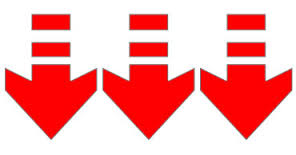 Dive Down
Dive Down